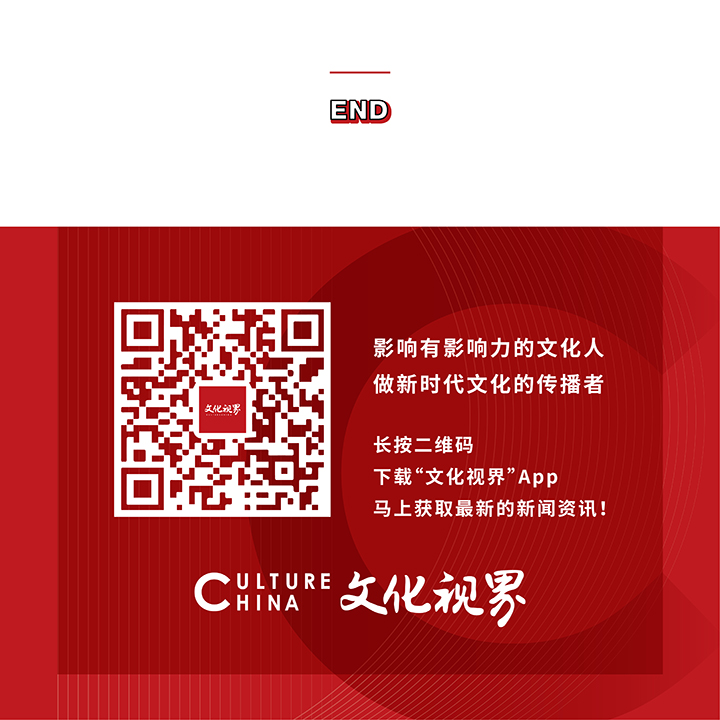

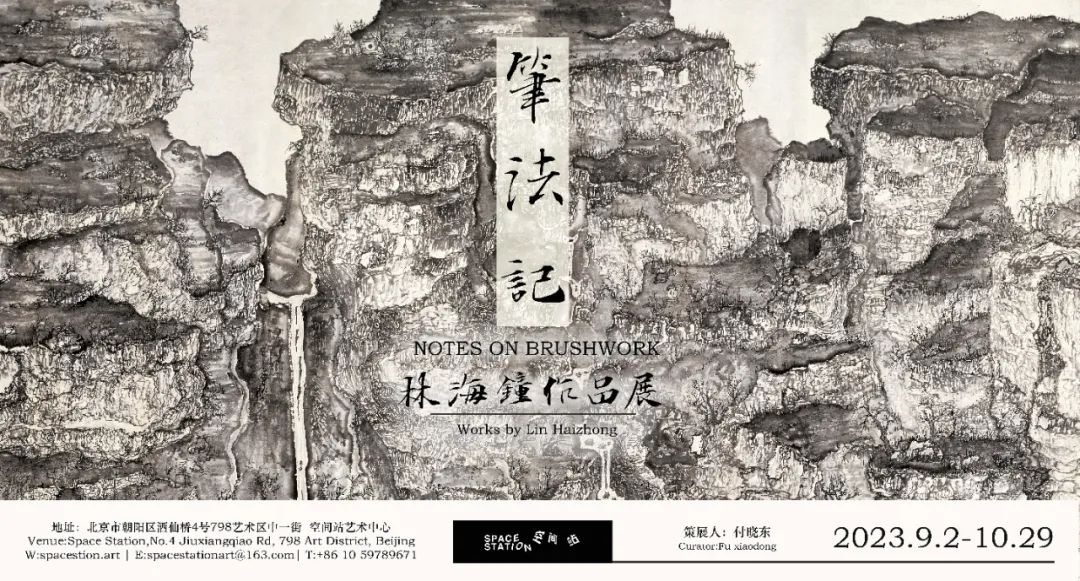
笔法记—林海钟作品展
NOTES ON BRUSHWORK — Works by Lin Haizhong
2023.9.2-10.29
开幕时间|Opening
2023.9.2(星期六)16:00
策展人|Curator
付晓东 | Fu Xiaodong
地址|Address
北京市朝阳区酒仙桥路798艺术中心中一街空间站
Space Station, No4 Jiuxianqiao Rd, 798 Art District, Beijing
 《笔法记》明嘉靖刻本台北故宫博物院(索书号:MF2)
《笔法记》明嘉靖刻本台北故宫博物院(索书号:MF2)
作为北宋山水画的开山大师五代时期隐居在太行山的荆浩(850\856年——923\936年)所撰写的《笔法记》,上承谢赫“六法”,后启两宋传灯,是中国画笔墨语言确立,丹青向水墨转型,人物画向山水画重心转移的枢纽性的关键文献。荆浩是业儒后隐的画家,能诗文,善文辞,由此形成了中国传统整个绘画样式、技术路径、审美价值和艺术精神的不同走向,区别于丹青绘的水墨画的发展路径,“遂为绘画正宗”(黄宾虹语)。《笔法记》在历史时间中留存版本众多,真伪考辨众说纷纭,学界主要观点为书有渊源,流传有绪,而非臆造。其观点与儒道思想结合之深,来自实践体验之切,后世影响之大,即使去其名亦是绘画实践思想史上不能绕过的扛鼎之作。书中所提出的核心价值“真”,评价标准的“六要(气、韵、思、景、笔、墨)”与“四品(神、妙、奇、巧)”,笔法中的具体要求“四势(筋、肉、骨、气)”与“二病(有形病、无形病)”,结合林海钟太行山纪游创作为线索,与他的山水画创作实践互相验证,从而进行深入阅读。并在西方图像学和风格论在AI算法取代之后,回到水墨山水画独立的原点,对绘画的根本问题重新思考,找到中国传统之中所蕴藏着的另外一种现代性的可能。
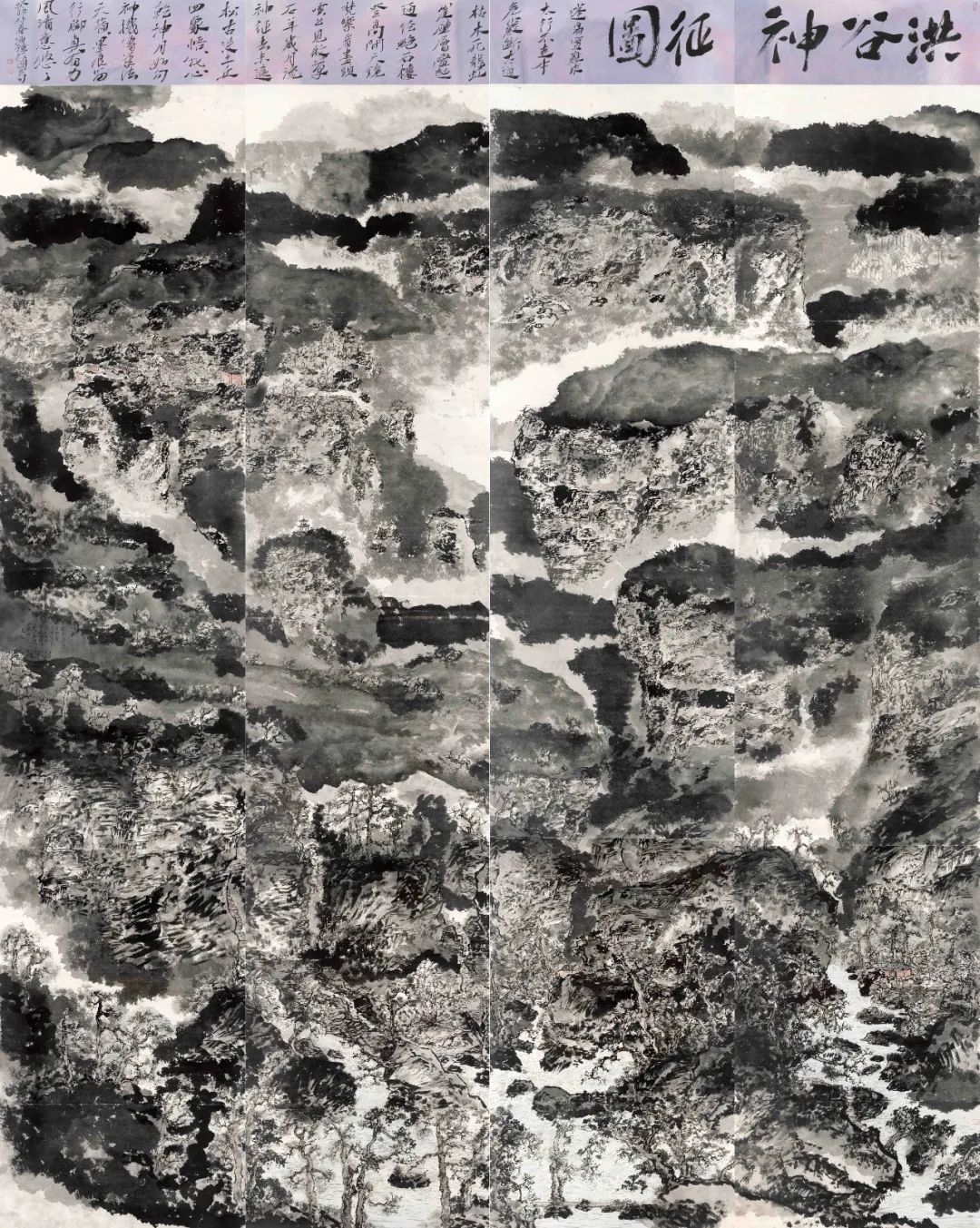 洪谷神征图纸本水墨 Ink on paper445×340cm2023
洪谷神征图纸本水墨 Ink on paper445×340cm2023
荆浩《笔法记》开篇即问“子知笔法乎?”引出以下三个问题
一、“真”与“气、韵”
“图真”和“气化论”乃是荆浩的核心观点。荆浩提出“度物象而取其真”,意指穷尽经验万物之名相而究其真。“不可执华为实”,物像的华彩即外在的形式与内在的实质不是一回事,分属两个层面,否定形式意义的唯一性。而是要把握其中的虚实之度,得其法,方可得真。“似者得其形,遗其气,真者,气质俱胜”。气不可能停留在形式层面,是生化万物的关系总和,“真”具有宇宙生化结构和质料实在的双重意义。“气质俱胜”,即是“质有而趣灵”(宗炳),气和趣都是依附在质之上的,通过华(画)来表现,而又不可执于华。
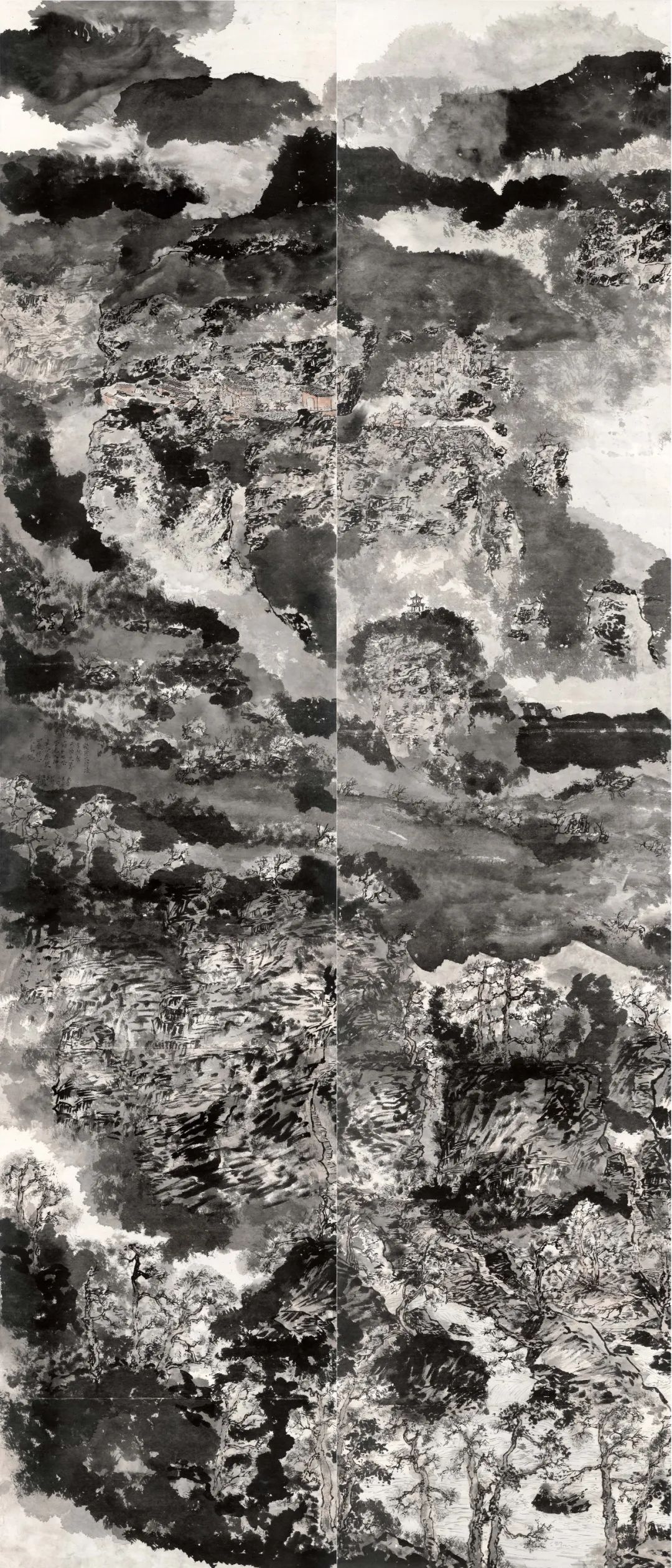 洪谷神征图(局部)纸本水墨 Ink on paper
洪谷神征图(局部)纸本水墨 Ink on paper
“真”在荆浩的《笔法记》中是画者所追求的本体状态,是有形有质的气化世界的本体。天地本为混沌一气,顺乎阴阳变化而成其形构。唐代的内丹学家认为宇宙的真相乃是一个真气周流的世界,宇宙的真相就是气,称为“真元之气”。“真”是一气孕化,生气、生机。万物真相,是不空之气铸造的生命精神。一个气化的世界体现于实体的物质世界之上,也就是“图真”的本意。如何体察真?荆浩提出了“嗜欲者,生之贼也“的观点,把绘画作为一种自我技术,通过一系列对思想、精神、行为、存在等方式的自我控制,从而达成自我转变,才能与自然承接,以获得智慧、完美、自由、超越的“真人”的状态。“真”即是一个道德自我的重新觉醒,从秩序化的道德世界迈向天理世界的途径。
 洪谷神征图(局部)纸本水墨 Ink on paper
洪谷神征图(局部)纸本水墨 Ink on paper
“真“字在许慎《说文解字》中释为“仙人变形而登天也,从匕,从目,从乚;八,所乘载也。”
《道德经》二十一章“惟恍惟惚……其中有精,其精(气)甚真”,四十一章“质真若渝”。五十四章“其德乃真”。
《庄子》《齐物论》“无损益乎其真”,“道恶乎隐而有真伪”,《大宗师》“反其真”,《天道》“极物其真,能守其本”,《秋水》“谨守而勿失,是谓反其真”,《山水》“见利而亡其真”,《渔夫》“真者,精诚之至也,真在内者,神动于外,是所以贵真也,真者,所以受于天也,自然不可易也”。“真”与道、气、自然、无为、德性等概念相关联,内在的指向一种天道,不可易的自然之本性,道既是真,内在的生命、气韵为真,朴实无华、自然而然,见利而亡,远离人伪为真。“真人”对应于得道升仙者,真宰、真知、真性、真画等概念也经常出现。

在儒家经典中《庄子·秋水》的“真者,精诚之至”中“真”的概念被置换成了“诚”。《中庸·治国篇》中“诚者,天之道也;诚之者,人之道也。诚者不勉而中,不思而得,从容中道,圣人也。“《周易》中的“阴阳二气”所孕化的宇宙生命也更接近于本源意义上“真”的观念。“生生之谓易,一阴一阳谓之道”,“生生不息”映现着一个真实的世界,“气”则成为万物本源处的生命动能。汉学家方闻指出:“在古代中国人眼里,绘画就如同《易经》中的象,具有造物的魔力,画家的目标在于把握活力与造物的变化,而不仅仅是模仿自然。”
唐末也是南宗禅盛行之时,禅宗的“立处即真”,“真即实,实即真”,也指出了“真”是存在本身即是意义。此心即佛,即心即佛。林海钟多年受禅法影响,经常用六触体验来描述绘画的状态,在作画的即刻,感官极近精微,瞬间的时刻在体验中被无限的拉长,心外无物,凝神注一。外界观其作画如同镜头快进,而其自身则如老僧补纳,丝丝分明。正是《笔法记》中所说:“气者,心随笔运,取象不惑。韵者,隐迹立形,备仪不俗。”如何才能“不俗”?荆浩又说“嗜欲者,生之贼也。明贤纵乐琴书图画,代去杂欲”。把琴书图画作为一种自我技术,通过日常的自我管理,去除各种奢欲,繁琐矫饰,遗物忘我,返归与自然和谐的境界,洗心进入无我无外精神陶冶的状态。如同《庄子·达生》中的佝偻丈人承蝉,吕梁丈夫游水,梓庆削木为鐻,都谈到不能把外在的评价系统置于关注自我和客观事物之前,是对外在权利系统的一种颠覆、限制,只有同过掌控自我的内在与真理系统联系到一起的时候,才能获得真正的自由。
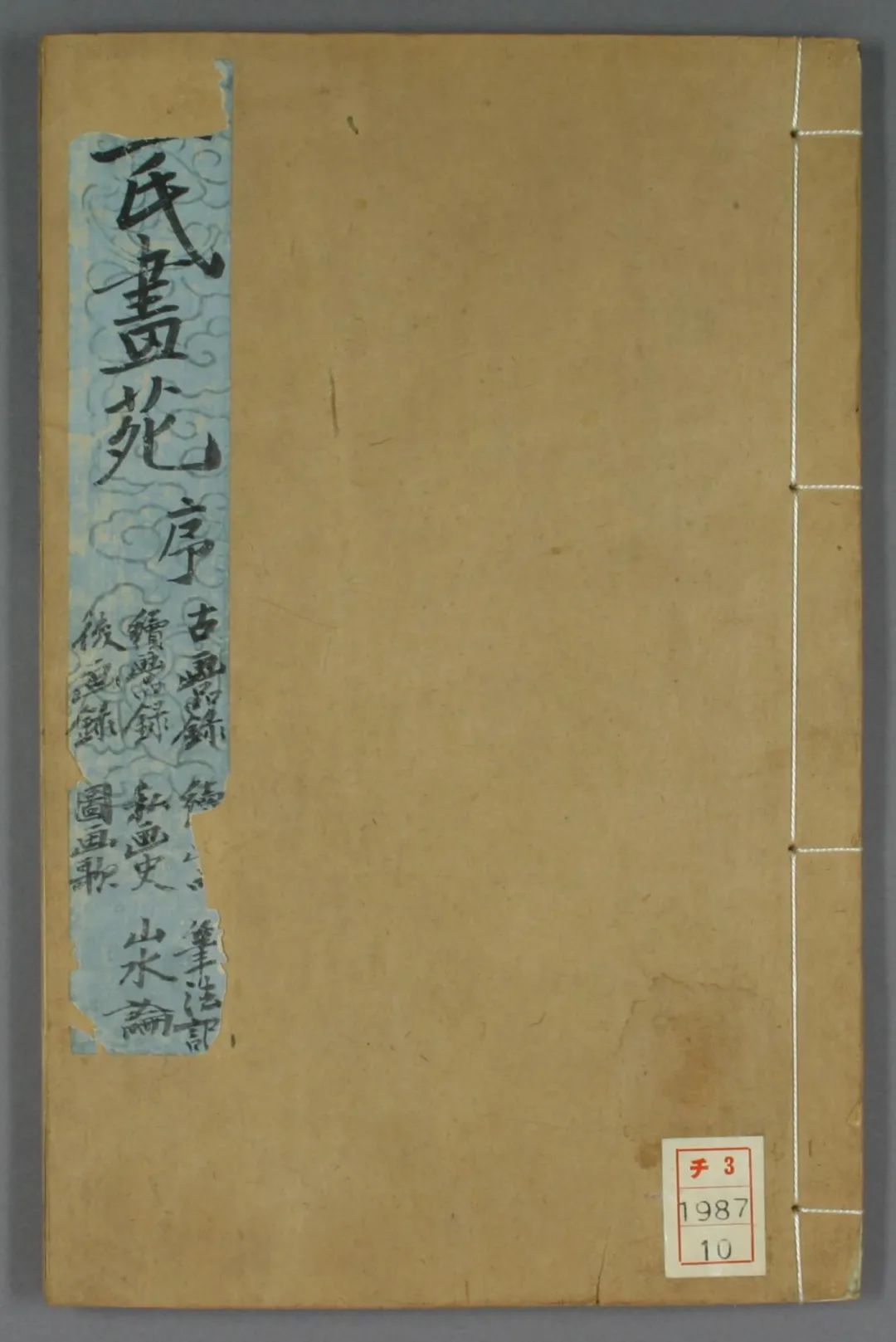 《笔法记》相关记载古籍版本 《王氏画苑》明万历十八年刻本 中国国家图书馆藏(索书号:/15620)
《笔法记》相关记载古籍版本 《王氏画苑》明万历十八年刻本 中国国家图书馆藏(索书号:/15620)
韦宾《唐朝画论考释》(第五章)中谈到:“然画之‘真’如何?人之真贵在顺其自然,物之真贵在得其原质,画之真曰‘气质俱胜’。则知画以‘气’为本,以形为末也。何者?质者,形也。实即言气也。故其华画之辩,真似之别,皆归之于‘气’也。”
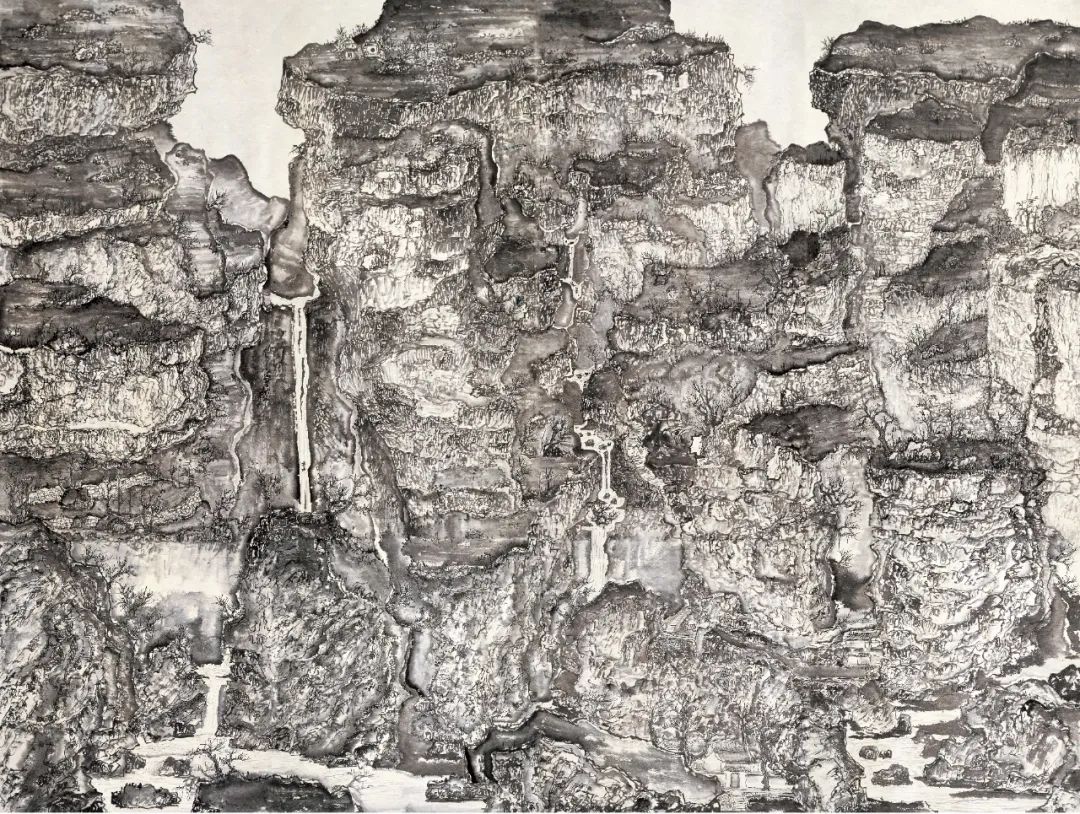 太行洪谷图纸本水墨 Ink on paper170x250cm2019
太行洪谷图纸本水墨 Ink on paper170x250cm2019
“真”作为荆浩画论里的最高价值,具有内向性的道德和精神取向,是通达气韵的途径,人得真而生气韵,物得真而俱气质。图真即是得天地之气,又是得人之本性与天地契合,借由画家个人的神韵气力,由此气韵生焉。北宋郭若虚《图画见闻志》中专有“气韵非师”一篇,“窃观自古奇迹,多是轩冕才贤,岩穴上士。依仁遊艺,探賾钩深,高雅之情,一寄於画。人品既已高矣,气韵不得不高;气韵既已高矣,生动不得不至。所谓神之又神,而能精焉。凡画必周气韵,方号世珍。”这里将道德世界与天理世界互相连接,气韵乃是绘画之中个人道德和精神世界修炼的再现,需经过自我体认和实践方可得实现,是艺术家不断打磨的内在心性的展现。在回归透彻的认识自我的本真之后,以无伪去掉复杂概念和固有思维的惯性投射,将自由的自我与自然万物本质的天理世界相应,方可得其“真”。
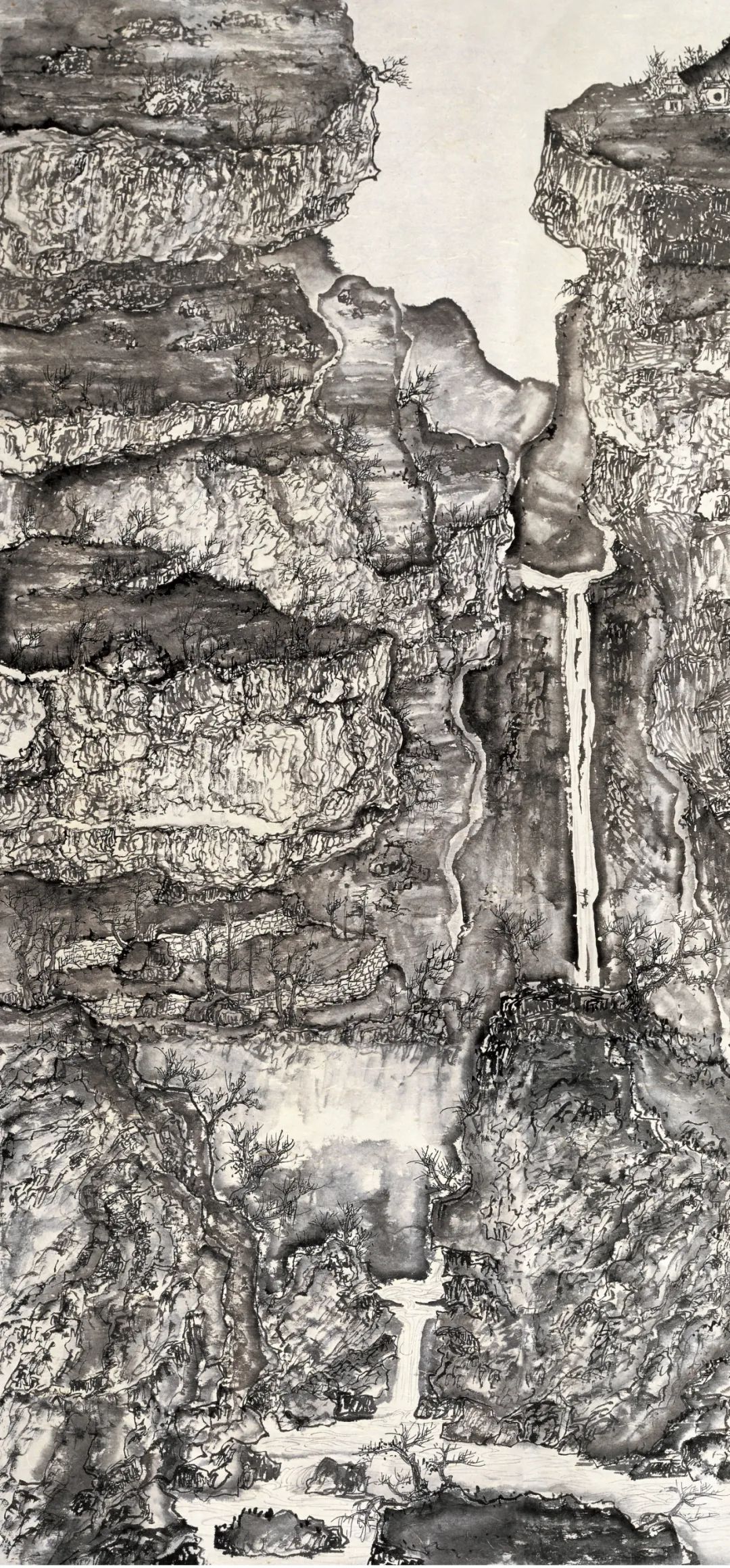 太行洪谷图(局部)纸本水墨 Ink on paper
太行洪谷图(局部)纸本水墨 Ink on paper
二、“笔、墨”与“四势”
“笔、墨”乃是《笔法记》六要中的要点,对笔墨体系的深入挖掘,继承和发展,也是林海钟绘画中多年来所探索的重要成就。“笔者,虽依法则,运转变通,不质不形,如飞如动。墨者,高低晕淡,品物深浅,文采自然,似非因笔”。又以用笔“四势”来深入规范,“凡笔有四势,谓筋、肉、骨、气。笔绝而不断谓之筋,起伏成实谓之肉,生死刚正谓之骨,迹画不败谓之气,故知墨大质者失其体;色微者败正气,筋死者无肉;迹断者无筋;苟媚者无骨。”
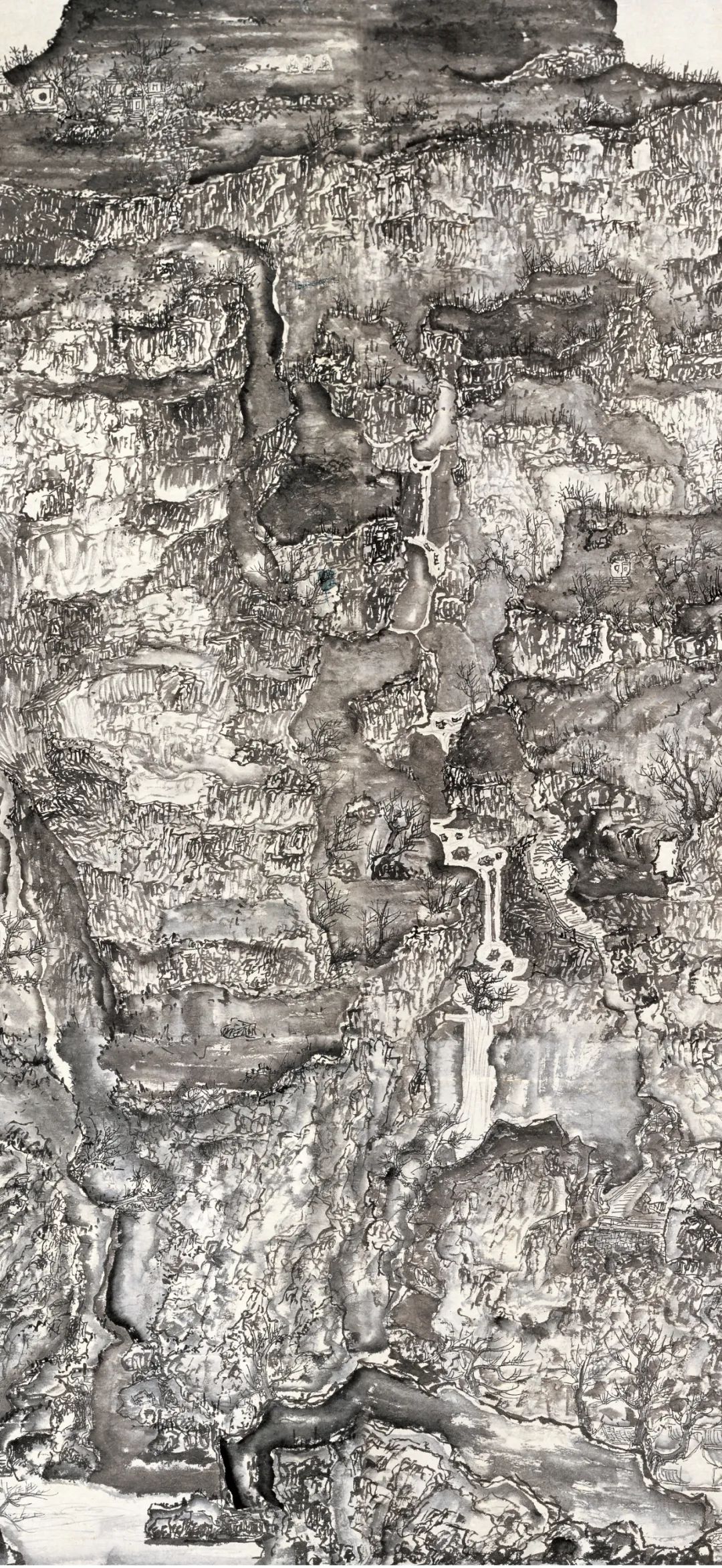 太行洪谷图(局部)纸本水墨 Ink on paper
太行洪谷图(局部)纸本水墨 Ink on paper
为什么“笔墨”会成为中国画固有的属性?在中国画的现代性变革中,不断的成为讨论的焦点?最后只能以“水墨”的材料属性来取代以“笔墨”为核心的中国画的称谓。那么毕加索用毛笔和宣纸绘画就是水墨吗?王冬龄用丙烯和亚克力材料书写就不是书法吗?“笔墨”与中国艺术的自我建构、自我训练和自觉成熟有关。笔墨是一种生命的形式。从汉代和魏晋南北朝时期,书法首先完成了艺术的自觉,建立了自身的语言体系。汉代章草脱离实用性功能,草圣张芝使书法成为书写者的个性表达。真正全面的自觉是行、楷和今草,即“今体”的出现,王羲之丰富变化而俱有审美理想的书法体系,成为了书法自觉的代表,也成为了后世发展的根基。东汉中期崔瑗的《草书势》、东汉末期蔡邕的《篆势》、《笔赋》,赵壹的《非草书》等,提出了“势”这一重要概念,《笔法记》的“四势”则承袭了此说。魏晋南北朝书论最重要的概念就是“笔”,笔的自身质量和抽象组合,生成“笔迹”,如“笔迹精熟”,“笔迹流怿”,“笔迹精佚”,“笔迹过鄙无法度”,“唯以笔迹得名”等。笔与力量结合,“笔力惊绝”,“笔力过于子敬”,“极有笔力”。对具体笔法的总结,“轻拂徐振,缓按急挑,挽横引纵,左牵右绕,长波郁拂,微势缥缈”(西晋成公绥)。南朝王僧虔《笔意赞》中描述了具体要求,“骨丰肉润,入妙通灵。努如植槊,勒若横钉。开张风翼,耸擢芝英。粗不为重,细不为轻。纤微向背,毫发死生”。南北朝书论重要的概念有笔、法、骨、势、自然、工夫等词汇,筋最高,其次为骨,肉为最末,是批判的对象。“筋胜之书含蓄,书技难度大,书品高;骨胜之书外于形,次之;肉书又次之”。“多力丰筋者圣,无力无筋者病。”(刘涛《中国书法史魏晋南北朝卷》)绘画理论的著作也稳定化,普遍化,宗炳的《画山水序》,王微的《叙画》,谢赫《古画品录》等,奠定了中国画的理论体系。对笔对要求则有“以一管之笔,拟太虚之体”,“骨法用笔”,“动笔新奇”……到了唐代张彦远的《历代名画记·论顾陆张吴用笔》说清楚了“一笔画”的来历。“昔张芝学崔瑗、杜度草书之法,因而变之,以成今草。书之体势,一笔而成,气脉通连,隔行不断。唯王子敬明其深旨,故行首之字,往往继其前行,世上谓之一笔书。其后陆探微亦作一笔画,连绵不断。故知书画用笔同法。张僧繇点曳斫拂,依卫夫人《笔陈图》,一点一画,别是一巧,钩戟利剑森森然,又知书画用笔同矣。国朝吴道玄古今独步,前不见顾陆,后无来者,授笔法于张旭,此又知书画用笔同矣。张既号‘书颠’,吴亦为‘画圣’,神假天造,英灵不穷。众皆密于盼际,我则离披其点画;众皆谨于象似,我则脱落其凡俗。”
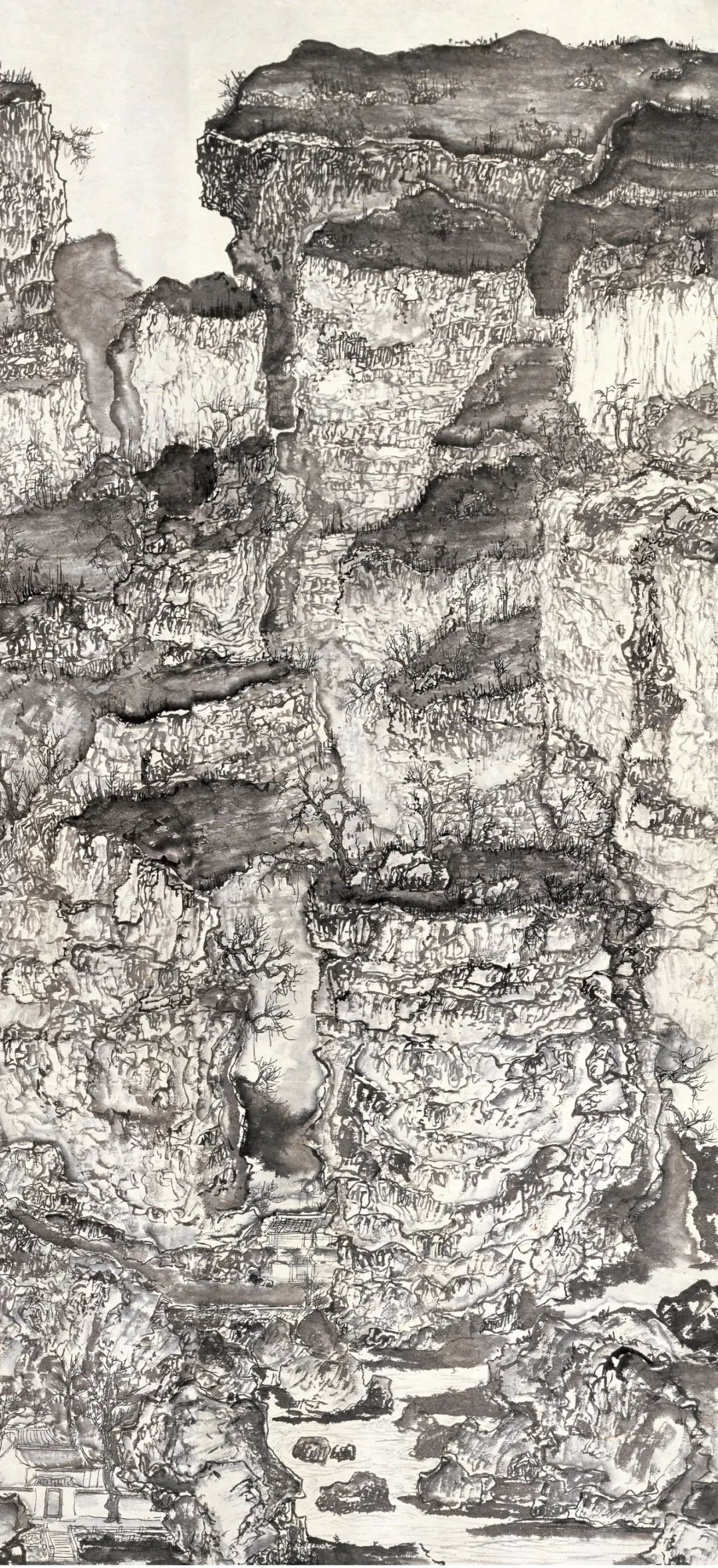 太行洪谷图(局部)纸本水墨 Ink on paper
太行洪谷图(局部)纸本水墨 Ink on paper
通过溯源,可以看到《笔法记》中所谈对笔的要求,“不质不形,如飞如动”即是对用笔独立审美的追求。“骨法用笔”即是有力,“一笔画”即是有筋。“笔者,虽依法则,运转变通”,法则就是用笔之法度,“变通”则是黄宾虹所谓“平、留、圆、重、变”之中的“变”字。这一点又是林海钟笔法的特点,画面上“一点一拂,皆出惊奇”,以刀法入笔的有质量的点划,如铁钩银划,笔势与组合摇曳生姿,顾盼多情,妍美而有力量。经过三十余年的锤炼,形成了自己独特而完善的笔墨结构。
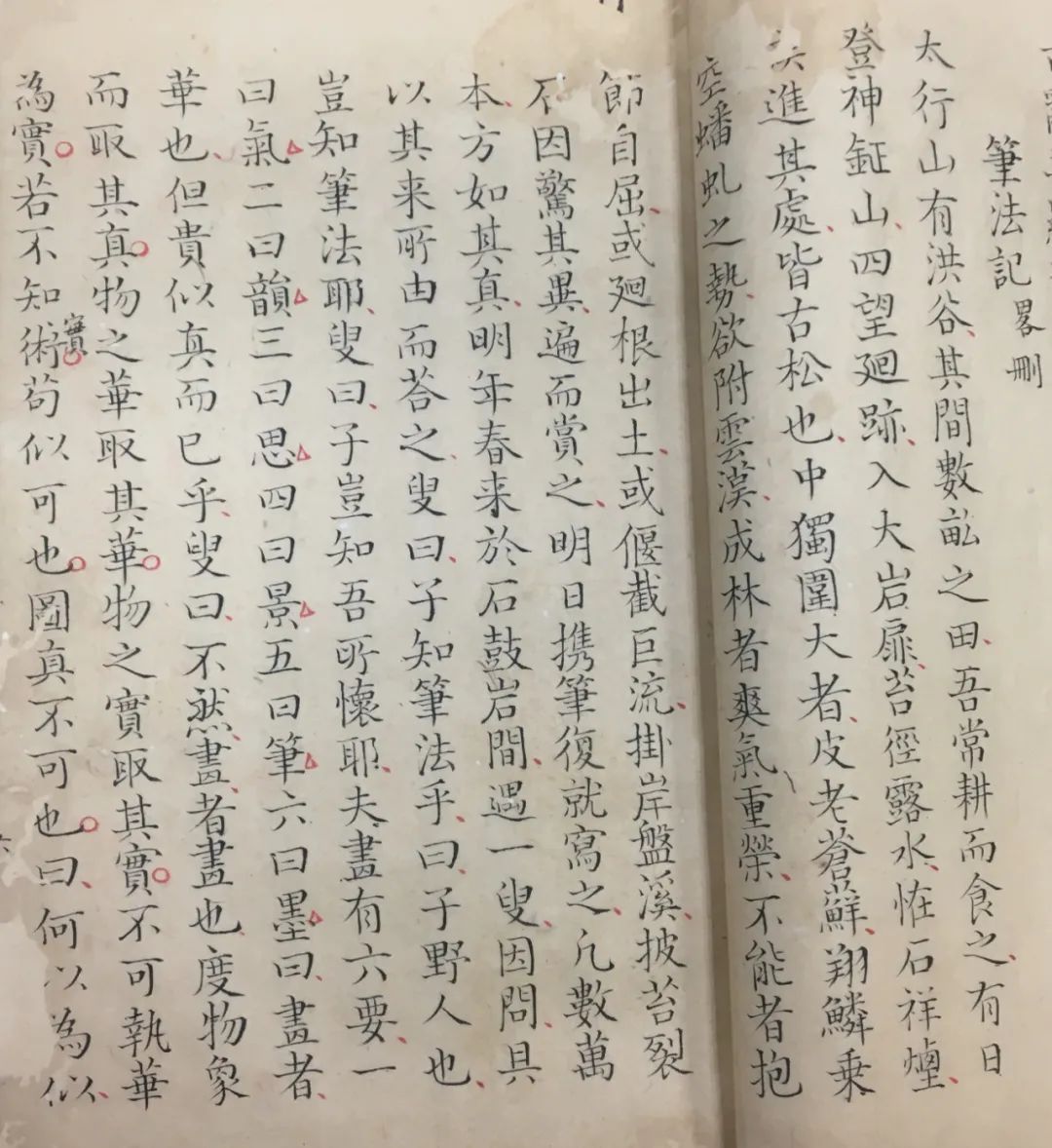 《繪事微言》明抄本浙江图书馆藏(索书号:善186)
《繪事微言》明抄本浙江图书馆藏(索书号:善186)
笔法与其说是一种技术系统,不如说是如何控制身心的对时间体验的方式,是一种自我操练和自我塑造的方式。在当下的时间过程中,凝神、注力、关注笔与笔之间连贯而复杂变化的关系,使精神的频率透过柔软的毛笔纤维万豪齐力,而古人所达到的精神自由的高度则留存在笔迹之中。这也是为什么禅宗和尚的临终绝笔凝聚了其一生的觉悟,中国传统则透过一根线的打造和磨练,而抵达精神体验的阈值。书法成为一种生命的形式,并且与中国画的结合,在中国的历史上出现,并不是偶然,是在西方的形体、图像和色块基础上建立和发展出来的另外一个精神力量的出口,一条独立的审美体系和自我训练的身心道路,依赖笔的运用所建立起来的生命力和精神微妙的结构。用笔亦是一种高难度的实践技艺,无论是从自我技术,审美规范,还是精神觉悟方面,成为被现代主义革命泼出去的脏水里的孩子,需要我们在回看传统的时候,重新审视和对待。林海钟笔精墨妙的探索和其他在用笔上不断实践的艺术家们,为我们当代人打开来依然可以进入古人探索自我的路径,通过自我技术,训练身心,从而达到的自由状态。
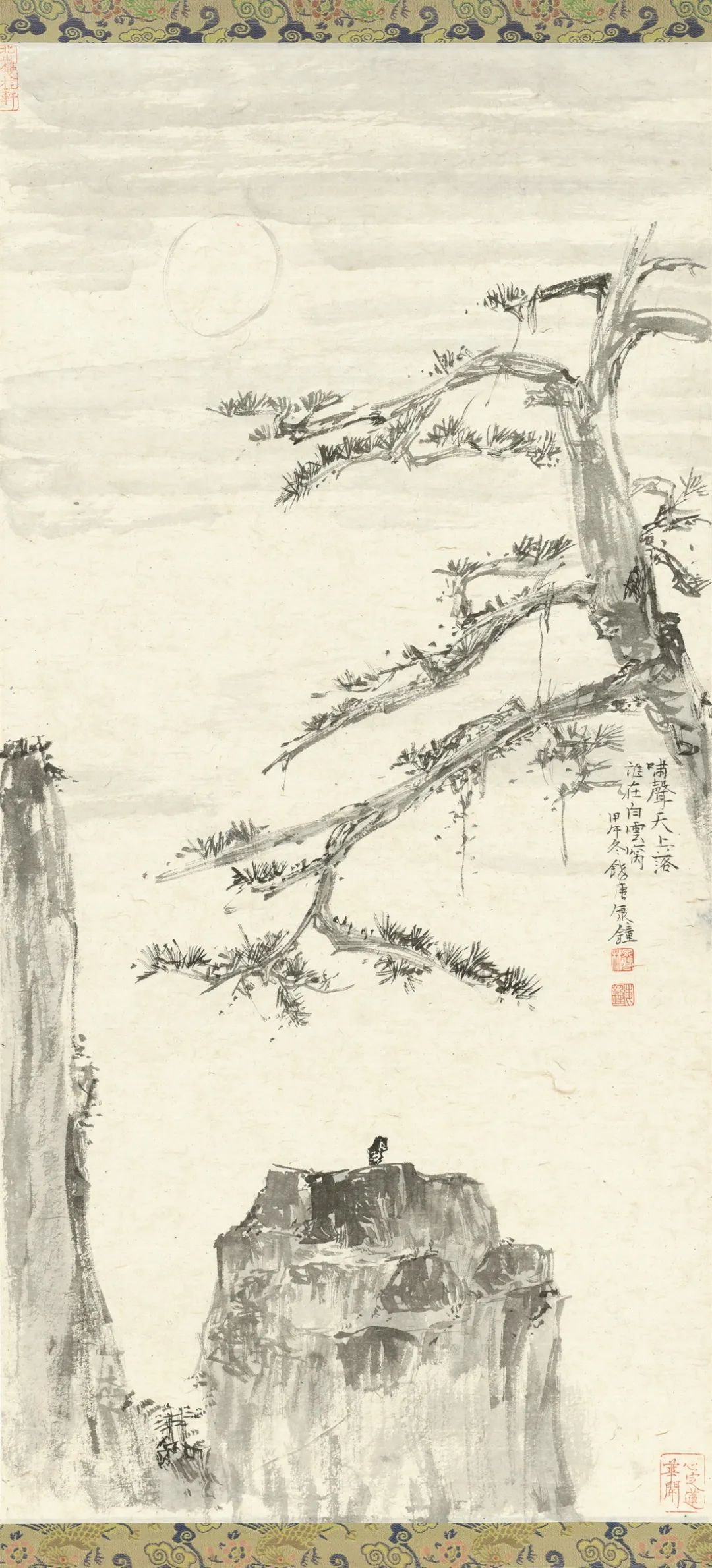 黄山图纸本水墨Inkonpaper33x68cm2014
黄山图纸本水墨Inkonpaper33x68cm2014
《笔法记》中云:“水晕墨章,兴吾唐代”,其墨法依然以染色视之。林海钟在此基础上,结合后继历代的画论,则提出“笔即是墨,墨即是笔”,用墨、用色亦需有笔的观点。唯有在墨中用笔,才能如石涛所言“墨海中绽放光明”,其实践在荆浩的基础上已有推进。
三、“思、景”与“四品”
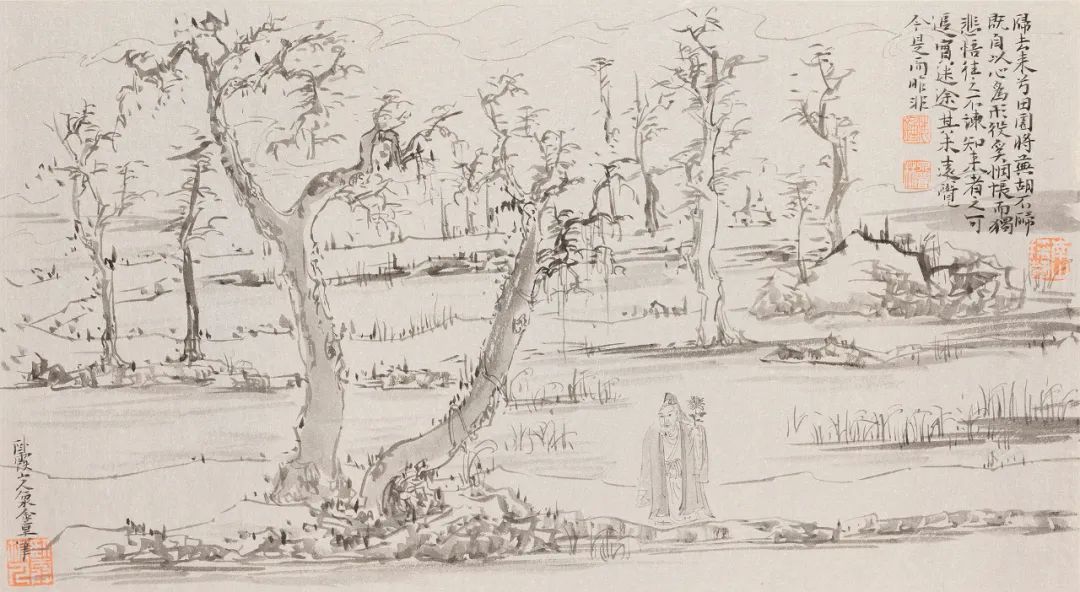 陶渊明归去来兮册(其二)贝壳笺水墨 Ink on shell paper23x40cm2013
陶渊明归去来兮册(其二)贝壳笺水墨 Ink on shell paper23x40cm2013
《笔法记》中云:“思者,删拨大要,凝想形物。”是关于整幅作品的主观性的取舍经营位置,和凝神观想式的感悟意境的营造,“景者,制度时因,搜妙创真。”这里有格物穷究山川之理的意思,遍及诸物像之妙,进而透显真相。四品是对“思”和“景”的进一步评判标准的阐明,其最高标准是“神者,亡有所为,任运成象”。表现了具有道家意旨符合的天道自然而然的生化概念。一切以无为而为的混沌组合的偶然性概率生成,是一种自然状态下的生成运动。可以理解为阴阳之气化现而来,是一种先在之理。“妙者,思经天地,万类性情,文理合仪,品物流笔”。则强调了山水画自上而下理性观看世界的视角。荆浩对松、柏长势特征结合“比德说”进行了详细论述,对楸、桐、椿、栎、榆、柳、桑、槐不同树种形质各异的生物多样性的观察,峰、顶、峦、岭、岫、崖、岩、谷、峪、溪、涧等地形地质的观察,雾云烟蔼的气象现象观察,说的是天地万物的经验内容所成,表现了一种尊重客观经验和自然规范,基于万物性相之体相二分的结构,观察天地万物自然生成之理,从天理化现到山水图景,俱有儒学义理的世界观特点。“奇者,荡迹不测,与真景或乖异。致其理偏,得此者,亦为有笔无思”。结合荆浩后面对其他画者的评价,可见他对“思”与“理”的重视,现实与理论世界的秩序变得十分重要,强调山水画的自然生成的秩序世界和现实途径,也对与真景违背的乖异的审美取向表达了一定程度的批判。“巧者,雕缀小媚,假合大经,强写文章,增邈气象。此谓实不足而华有余。”对于工巧小媚和僵化作伪的强烈鄙视,把作品内在的与大道契合提到了绝对的位置上来。现象的背后的真相是超越一切色相的“性”、“理”、“道”,非一切表面上的工巧所可及。
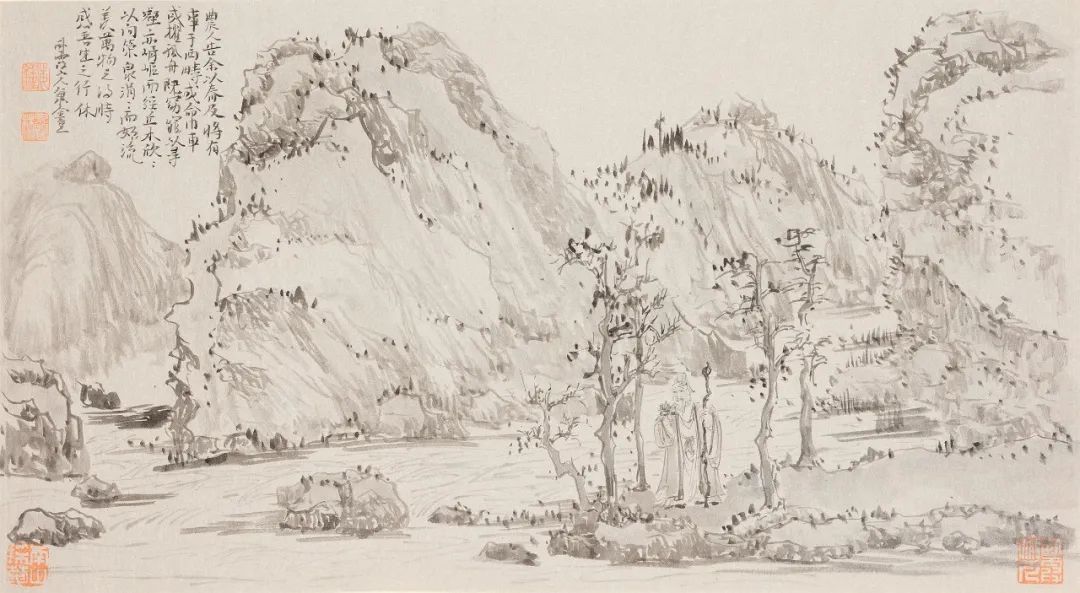 陶渊明归去来兮册(其八)贝壳笺水墨 Ink on shell paper23x40cm2013
陶渊明归去来兮册(其八)贝壳笺水墨 Ink on shell paper23x40cm2013
比较稍晚的宋代画论郭熙的《林泉高致》中对山水境界的描述:“君子之所以爱夫山水者,其旨安在?丘园,养素所常处也;泉石,啸傲所常乐也;渔樵,隐逸所常适也;猿鹤,飞鸣所常亲也。尘嚣缰锁,此人情所常厌也。烟霞仙圣,此人情所常愿而不得见也。……然则林泉之志,烟霞之侣,梦寐在焉,耳目断绝,今得妙手郁然出之,不下堂筵,坐穷泉壑,猿声鸟啼依约在耳,山光水色滉漾夺目,此岂不快人意,实获我心哉,此世之所以贵夫画山之本意也。不此之主而轻心临之,岂不芜杂神观,溷浊清风也哉!”
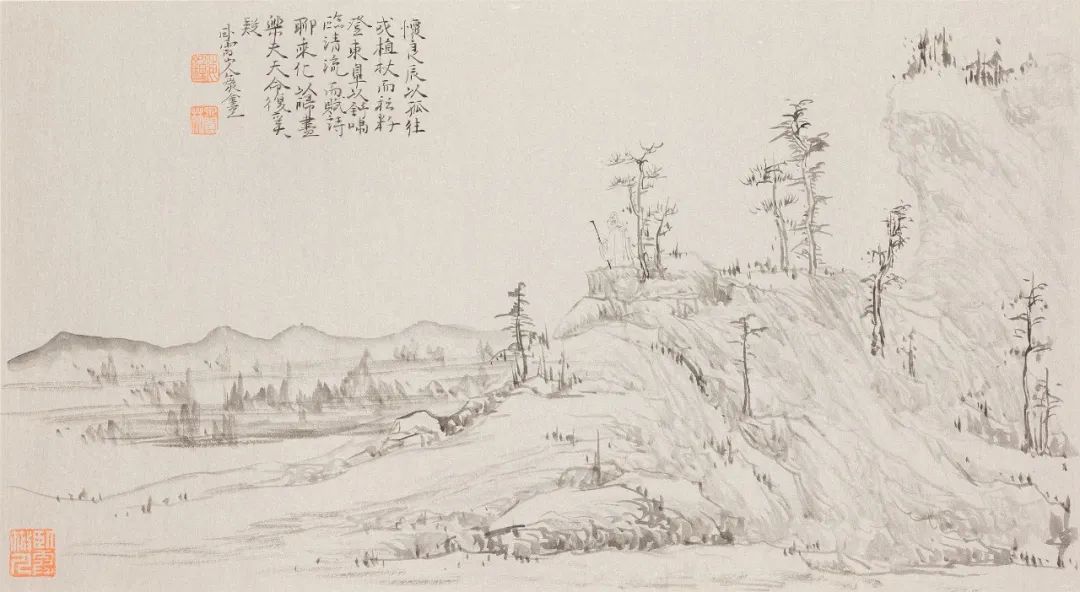 陶渊明归去来兮册(其十)贝壳笺水墨 Ink on shell paper23x40cm2013
陶渊明归去来兮册(其十)贝壳笺水墨 Ink on shell paper23x40cm2013
山水于五代两宋期间,即尽性、达理,亦可通情,于离世绝俗之地,舒隐逸遁世之情。这也是林海钟一种基本的心灵状态,古仁人之规范于多年来的研习之中竟一一破境,于山川中探究穷理,颐养烟霞之志,乃是安置人生的一个恰当处。伴着对《笔法记》的阅读和理解,品读林海钟数次太行山之行的满纸灿然的精彩画作,还有范厉老师所剪辑对太行山行旅的视频纪录和高津在全世界图书馆拍到的历代《笔法记》的版本,邀约我们进入到林海钟所打造的体道之所,造化之境。
(文/付晓东 2023年8曰13日于杭州)
Notes on Brushwork: Lin Haizhong’s Journey Through the Taihang Mountains
By:FuXiaodong
As the founding master of landscape painting in the Northern Song Dynasty, Jing Hao (850/856 – 923/936), a recluse in the Taihang Mountains during the Five Dynasties period, wrote Brushwork Notes, which inherited from Xie He’s “Six Methods”, and initiated the transmission of painting tradition from the Northern Song Dynasty to the Southern Song Dynasty, and was a pivotal document for the establishment of the language of brushwork and inkwork in Chinese painting, and hence the transformation of painting into ink and wash. Jing Hao was a painter who was a Confucian scholar and then a recluse, capable of poetry and good at rhetoric, thus forming a different route for the entire traditional Chinese painting style, technical path, aesthetic value and artistic spirit, which distinguished from the route of painting in red and green colors, and “became the authentic painting” (in the words of Huang Binhong). There are many versions of Brushwork Notes that have survived through history, and there are many different opinions on its authenticity, but the main viewpoint of the academic community is that the book has its origins and has been passed down in a certain way, rather than being a fabrication. Given the depth of the combination of its viewpoints with Confucian and Taoist thought, the accuracy of its experience from practice, and the influence of later generations, even if its name is removed, it is also a masterpiece that cannot be bypassed in the history of painting practice and thought. The core value presented in the book is “truth”. The evaluation criteria of “six essentials” (Qi, Yun, Thought, Scene, Stroke and Ink) and “four qualities” (spirit, subtlety, strangeness and ingeniousness), and the specific requirements of “four potentials” (sinew, flesh, bone, breath) and “two diseases” (tangible and intangible), can be deeply understood by combing with Lin Haizhong’s Journey through the Taihang Mountains as a clue and verifying them with his landscape painting practice. After the replacement of Western iconography and stylistics by AI algorithms, it is important to return to the origin point of independence of ink and landscape painting, to rethink the fundamentals issues of painting, and to find another possibility of modernity embedded in the Chinese tradition.
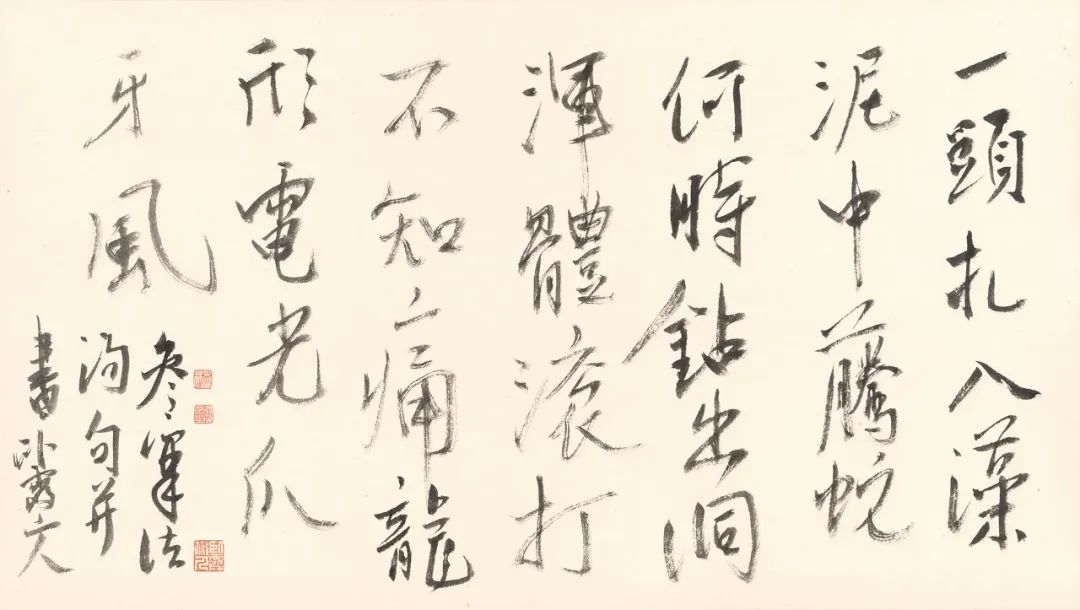 参笔法纸本水墨 Ink on paper34.5x61cm2016
参笔法纸本水墨 Ink on paper34.5x61cm2016
Jing Hao’s Brushwork Notes begins with the question, “do you know brushwork?” This leads to the following three issues.
I. “Truth” and “Qi and Yun”
“Aiming at truth” and “Qi transformation theory”(气化论) are the core ideas of Jing Hao. He puts forward the idea of “pondering the images of things and taking their truth”, which means to exhaust the name and appearance of things in experience and to investigate their true nature. “Do not stick to the appearance with colors and take it as the real”: that is to say, the external form and the internal substance are not the same thing, belonging to two levels, denying the uniqueness of the meaning of the form. Rather, it is necessary to grasp the proper proportion between the real and the imaginary. We can get the truth only if we get the laws in things. “What is like gets its form and lose its Qi, and what is true prevails both in its Qi and matter.” Qi cannot stay in the level of form. It is the sum of the relationship between the becoming of things, and “truth” has the dual significance of the cosmic becoming structure and material reality. “What is true prevails both in its Qi and matter”, that is to say, “there are qualities, and interests are spiritual” (Zong Bing), Qi and interest are attached to matter, represented by paintings but not stick to them.
 《画学心印》清光绪四年朱墨套印本秦祖永
《画学心印》清光绪四年朱墨套印本秦祖永
In Brushwork Notes, the “truth” is the ontological state pursued by painters, the substance of the world of Qi which has form and matter. Heaven and earth are originally chaotic, and then formed by the interplay of Yin and Yang. In the Tang Dynasty, Neidanists believed that the truth of the universe was a world in which Qi flowed around, and that the truth of the universe was Qi, which was called “true Qi”. The “truth” is the unique Qi that nurtures, gives life to, and gives birth to. The truth of all things is the spirit of life forged by the non-empty Qi. A world of Qi is embodied in the physical world, which is the original meaning of “aiming at truth”. How to understand the truth? Jing Hao puts forward the idea that “lusts spoil life”, treating painting as a kind of self-technique, a series of self-control of thought, spirit, behaviour and existence through which achieves self-transformation, so as to connect with nature, in order to obtain the wisdom, perfection, freedom, transcendence and the state of a “true man”. Being true is the re-awakening of a moral self, the way to move from the ordered moral world to the heavenly world.
In Xu Shen’s Explanation of Characters in Chinese, the character “truth”(真) is interpreted as “the immortal who transforms and ascends to heaven, consisted of匕, 目, 乚, and八, the carriers he rides on.”
In Tao Te Ching, “... there is essence in it, and its essence (Qi) is very true” (Chapter 21). “The matter of truth is like dirty” (Chapter 41). “Its virtue is true” (Chapters 54).
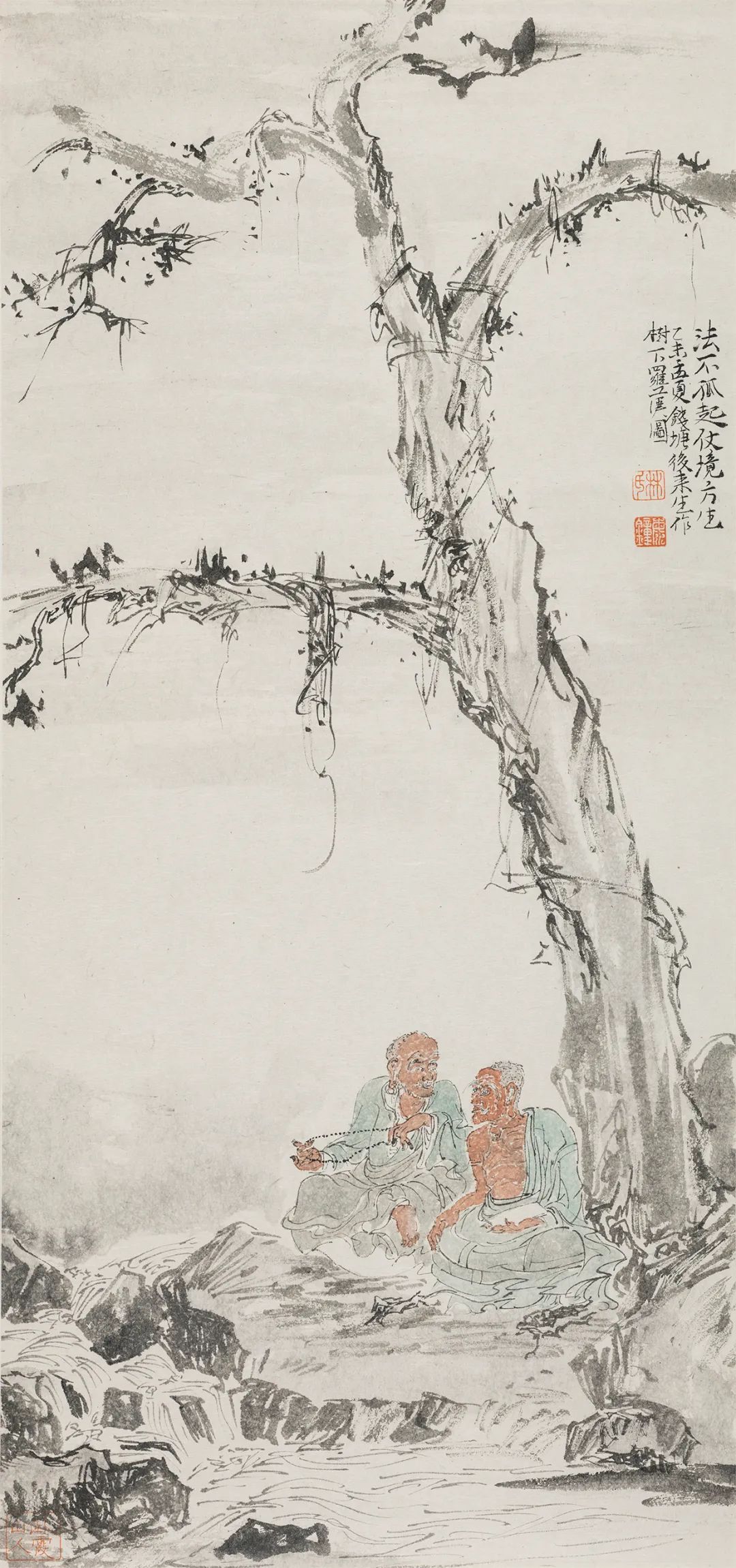 树下罗汉纸本水墨 Ink on paper31x67cm2015
树下罗汉纸本水墨 Ink on paper31x67cm2015
In Zhuangzi, “There is no loss or gain to its truth”; “The Tao abhors hiding itself, but there is truth and falsehood therein”. (Working Everything Out Evenly) “Against its truth”. (The Great and Venerable Teacher) “Being careful to keep and not to lose is the opposite of the true”. (Autumn Floods) “One forgets what is true to himself when tempted by personal gains”. (The Huge Tree) “What is true is what sincerity reaches [...] What is true resides inside, and the spirit moves outside, so the true is valued. [...] For its origin in the Heaven, what is true by nature does not change”. (The Old Fishman) “True” is associated with the concepts of Tao, Qi, nature, wuwei, and virtue, which inherently looks to a kind of heavenly way. The term “true man” corresponds to a person who has attained immortality, and the concepts of “true master”, “true knowledge”, “true disposition” and “true painting” also appear frequently.








 汴河桃园图卷纸本水墨 Ink on paper340x30cm2020
汴河桃园图卷纸本水墨 Ink on paper340x30cm2020
In the Confucian classics, “truth” is replaced by “sincerity”. In The Ruling of the State (Zhongyong), “Sincerity is the way of heaven, hence the way of man. A sincere person does not have to force himself to be reasonable and does not have to think about the rightness of his acts and words, reaching the Middle Way with ease and grace. Such a person is sage”. The life of the universe as conceived by the two Qi’s, i.e., Yin and Yang in the Zhouyi, is also close to the concept of truth in the original sense. “The endless becoming is called Yi(易), and the interplay of Yin and Yang is called the Tao”, and the endless becoming reflects a real world, while the Qi’s become the vital energy at the origin of all things. According to Chinese scholar Fang Wen, “For the ancient Chinese, painting was like the image in the Zhouyi, with the magic of creation, and the painter’s goal was to grasp the vitality and change of creation, not just to imitate nature”.
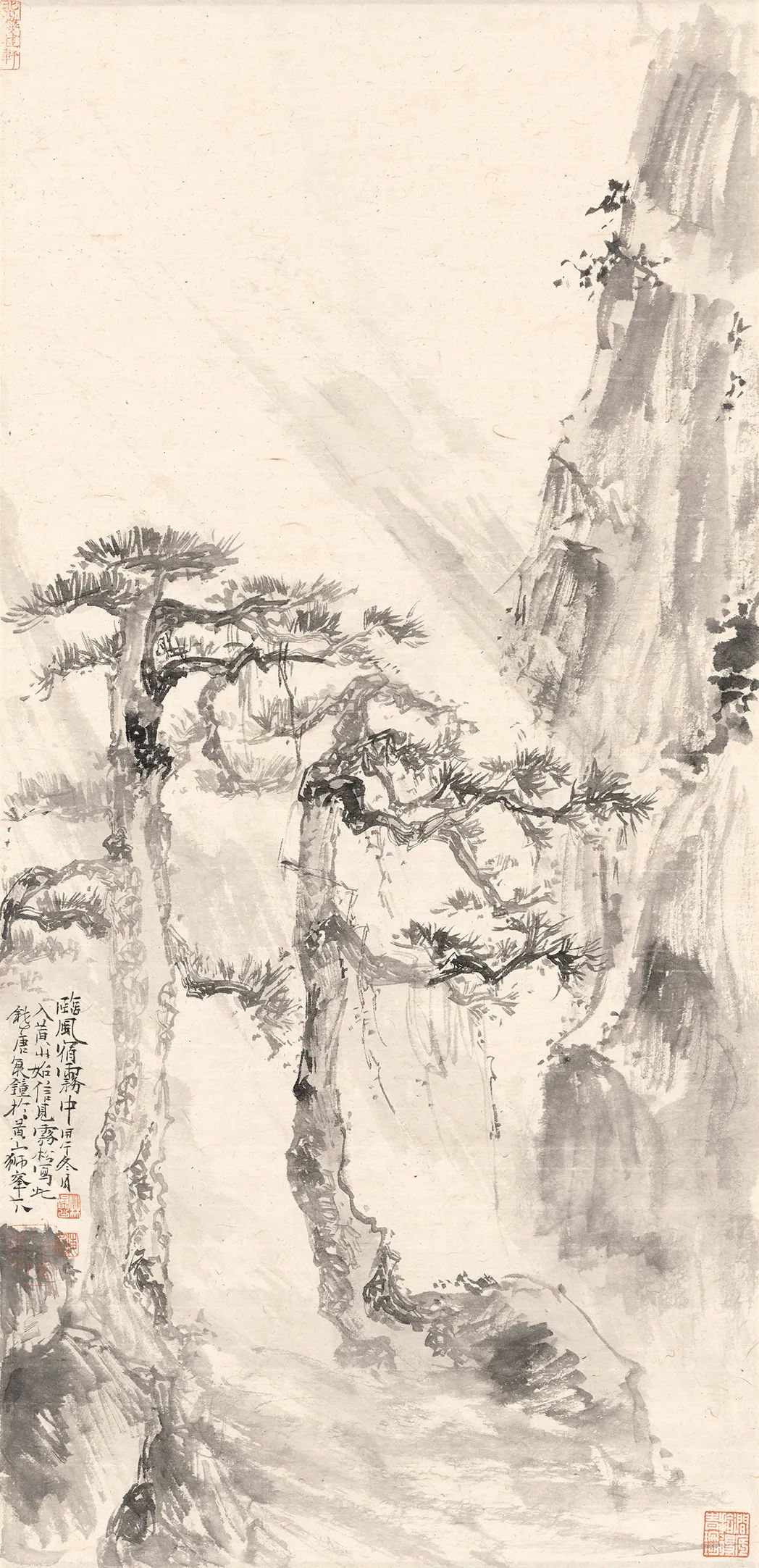 黄山雾松始信峰所见纸本水墨 Ink on paper68.5x33cm2014
黄山雾松始信峰所见纸本水墨 Ink on paper68.5x33cm2014
At the end of the Tang Dynasty, Southern Zen was in full bloom. In saying that “the place where one stands is the truth” and that “truth is reality, and reality is truth”, the Zen also pointed to the fact that the “truth” is the existence itself. This mind is Buddha, and the mind is Buddha. Lin Hai Zhong has been influenced by Zen for many years,often uses the six touches of experience to describe the state of painting. In the moment of painting, the senses are extremely close to the subtle, and the instantaneous moments are infinitely elongated in the experience, with nothing outside the mind and the concentration of the mind on the one. Others view his painting as if the camera is fast-forwarding, while he himself is like an old monk mending clothes, with a clear understanding of the needlework. It is exactly what is said in the Brushwork Notes: “It is Qi that allows the mind to follow the brush, with no confusion in acquiring the image. And it is Yun that hides the traces of the shape, with the representation that is not vulgar”. How to be “not vulgar”? Jing Hao also says that “lusts spoil life. Men of intelligence and integrity indulge themselves in music, books and paintings by which replace miscellaneous desires”. Music, books and paintings as a self-technology, through the daily self-management, remove all kinds of extravagant desires, cumbersome decorations, and the remains of the self, return to the realm of harmony with nature, wash the heart into the state of non-I. As in Grasping the Purpose of Life (Zhuangzi), the rickety old man who sticks cicadas with a bamboo pole, the young man who swims in the water in Luliang, and Ziqing who chisels wood for his instrument, all of them talk about the inability to put the external evaluation system before paying attention to the self and the objective, and it is a kind of subversion and limitation of the external right system, and the only way to obtain the real freedom is to be connected with the internal and truth system that controls the self.
In his Examination and Explanation of Tang Dynasty Paintings, Weibin says (Chapter 5), “But how is the truth of painting? The truth of man is to follow nature, and the truth of object is to get its primitive matter, and the truth of painting is said to be ‘prevailing in both its Qi and Matter’. Then we know that painting is based on Qi and ended in Form. Why? It turns out that what we call Matter is Form. The real is Qi. Therefore, the debate of Chinese painting, the difference between authenticity and likeness, are all attributed to Qi”.
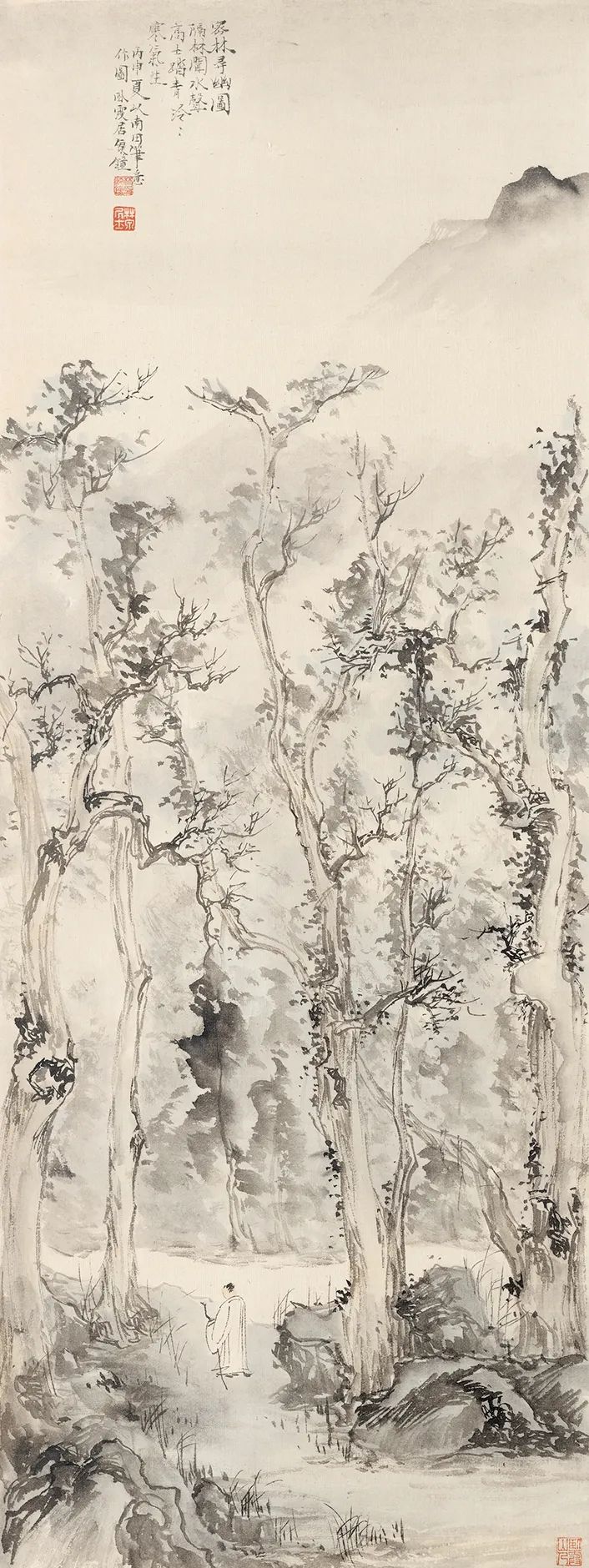 密林寻幽图纸本水墨 Ink on paper31x81cm2016
密林寻幽图纸本水墨 Ink on paper31x81cm2016
As the highest value in Jing Hao’s theory of painting, truth has an inward moral and spiritual orientation, and is the way to access Qi and Yun, so that, by acquiring the truth, people can generate Qi and Yun, and things can generate Qi and Matter. Aiming at truth is not only to get the Qi of heaven and earth, but also to reach the harmony of man and heaven and earth; through the personal charm of the painter, Qi is generated. In the special essay Qi-Yun is Unavailable from Being Taught (Insights into Painting), Guo Ruoxu in the Northern Song Dynasty says, “Looking at the talents since ancient times, I find that many of them are high-ranking officials or reclusive Confucian scholars. They wander all over the world of art in their kindness, exploring the profound and subtle knowledge, and their perfect good tastes completely reflect in their paintings. Given their character, Qi-Yun in their paintings cannot be low; and given the strong Qi-Yun, the livingness has to come in. All paintings must have a good sense of Qi-Yun before they can be called treasures”. Here, the world of morality and the world of heavenly principles are connected to each other, and Qi-Yun is the representation of personal morality and spiritual cultivation in painting, which can only be realized through self-awareness and practice, and is the display of the artist’s disposition that is constantly being polished. After returning to a thorough understanding of one’s authenticity, one can acquire the “truth” by removing complex concepts and the inertia of inherent thinking with no falsehoods, and by connecting one’s free self to the world of heavenly principles which is the essence of all things.
II. “Brush and Ink” and “Four Potentials”
Brush and ink are two essentials in Brushwork Notes, and the in-depth excavation, inheritance and development of the brush-ink system is also an important achievement that Lin Haizhong has explored in his paintings over the years. “The brushwork, although following rules, operates flexibly, without matter or form. Ink is a type of painting that shades in representing things, seemingly unrelated to brush”. Moreover, four potentials are further normalized: “there are four potentials in all brushes, which are called sinew, flesh, bone, and breath. That brush ceases but not broken is called sinew. That undulation into a real is called flesh. That life and death are represented rigidly is called bone. That traces of painting are not tarnished is called breath. So, I know that ink outdoing matter loses its body; the vanishing looks spoil normal breath, and the stiff sinews have no flesh; the broken traces have no sinew, and the obsequious has no bone”.
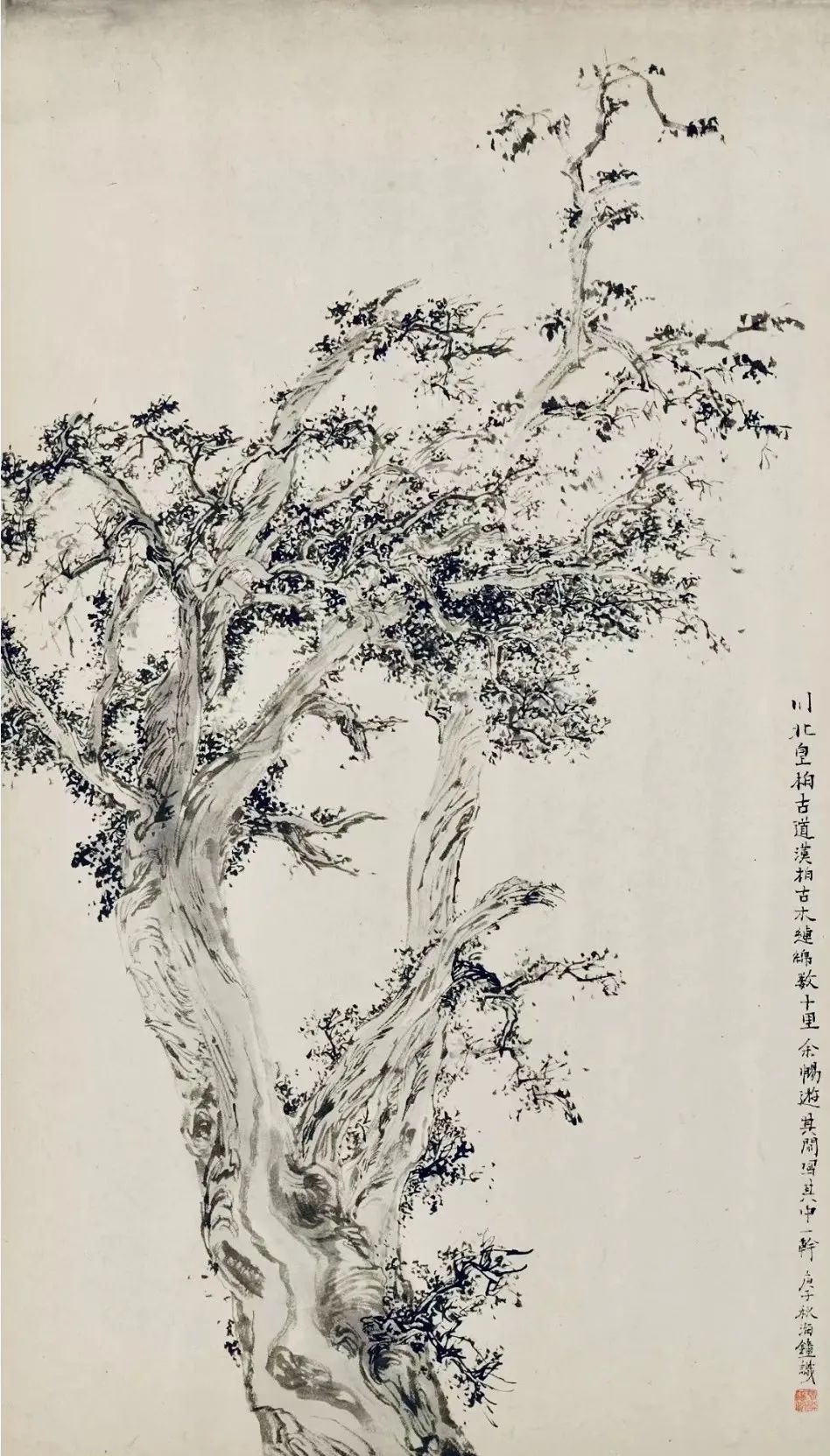 皇柏古道纸本水墨 Ink on paper37x64cm2020
皇柏古道纸本水墨 Ink on paper37x64cm2020
Why has “brush-ink” become an inherent attribute of Chinese painting? And why has it constantly become the focus of discussion in the modern transformation of Chinese painting? In the end, the material property of “water-ink” can only be used to replace the title of Chinese painting with “brush-ink” as its core. Is Picasso’s painting with brush and Xuan paper wash painting? Is Wang Dongling’s writing with acrylic materials not calligraphy? The term “brush-ink” is related to the self-construction, self-training and conscious maturity of Chinese art. Brush and ink is a form of life. In the Han Dynasty and the Wei, Jin, and Northern and Southern Dynasties, calligraphy first completed its artistic self-awareness and established its own language system. During the Han Dynasty, the cursive script of Chinese calligraphy was detached from its utilitarian function, and Zhang Zhi, the sage of cursive script, made calligraphy an expression of the writer’s personality. The real comprehensive self-consciousness was the emergence of running script, regular script and present cursive script, i.e., “present style”. Wang Xizhi’s rich and varied calligraphy system with aesthetic ideals became the representative of the self-consciousness of calligraphy, and also became the foundation for the development of the later generations. Cui Yuan’s Cursive Script’s Potential in the middle of the Eastern Han Dynasty, Cai Yong’s Seal Script’s Potential and Brush Fugue in the end of the Eastern Han Dynasty, and Zhao Yi’s Non-Cursive Calligraphy put forward the important concept of potential, from which the four potentials in Brushwork Notes inherited. The most important concept in the calligraphy of the Wei, Jin and Northern and Southern Dynasties is “brushwork”. The matter of brushwork itself and its abstract combinations generate the “handwriting”, such as “proficient handwriting”, “fluent handwriting”, “outstanding handwriting”, “the handwriting is too poor to measure”, and “being famous only for his handwriting” and so on. There are also combinations of brushwork and power, such as “the power of the brushwork is amazing”, “its power outdoing Wang Zijing’s”, “extremely powerful brushwork”. There is a summary of brushwork: “lightly brushing and slowly wiping, relaxedly pressing and sharply poking, drawing horizontally and leading longitudinally, pulling leftward and winding rightward” (Cheng Gongsui, who lived in the Western Jin Dynasty). In In Praise of the Mood of Brushwork written by Wang Shengqi of the Southern Dynasty, specific requirements of brushwork were described as follows: “Bone and flesh should be plentiful and tender, getting into the spirit. Vertical strokes should be like a lance, and horizontal ones a nail. Stretching out should be like the phoenix spreading the wings, and standing out should be like Lingzhi standing upright. Thick strokes are not pressed heavily, and thin ones are not wiped gently. Strokes run back and forth, even if the slightest ones are related to the quality of characters”. Calligraphy theories in the Northern and Southern Dynasties include many important concepts: stroke, rule, bone, potential, nature, and work. Sinew is the highest, followed by bone, and the last one is flesh, the object of criticism. “Scripts superior in sinew are reserved, which need difficult skills, higher in quality. Scripts superior in bone, represented in their shapes, are inferior; and scripts full of flesh are the worst ones”. “Scripts that have much strength and abundant sinews are lofty, and those that have no strength and no sinew are flawed”. (Liu Tao, Chinese Calligraphy History of the Wei, Jin, and Northern and Southern Dynasties) Painting theory works are also stabilized: Zong Bing’s Of Painting Shanshui, Wang Wei’s On Painting, Xie He’s Ancient Paintings, and many others, laid down the theoretical system of Chinese painting. The requirements for the brushwork are “to imitate the body of emptiness in one brushstroke”, “the bone method of using the brush”, and “the novelty of the brushwork” ... By the Tang Dynasty, Zhang Yanyuan’s On the Brushwork Deployed by Gu, Lu, Zhang and Wu (Records of Famous Paintings of All Ages) made clear the origin of “one brushstroke”: “in the past, Zhang Zhi learnt from Cui Yuan and Du Du’s methods of cursive script, and thus changed it to become the present cursive script. The posture of the script is formed by one stroke, and Qi flows through the connection, without breaking in neighboring lines. It was only Wang Zijing who grasps its deep purpose, so the character at the beginning of the line often follows its predecessor – that is called the script in one stroke. Later, Lu Tanwei also practiced painting in one stroke. Therefore, it is known that calligraphy and painting use the same method. Zhang Sengyou’s pointing, dragging, chopping,and wiping, following the instructions of Mrs. Wei’s On the Potentials of Stroke,are differently ingenious. It is also known that calligraphy and painting use the same brushwork. Wu Daoxuan was unique both in ancient and present times, without seeing Gu and Lu or anyone coming from behind. He taught Zhang Xu in penmanship, which also revealed that calligraphy and painting use the same brushwork. Since Zhang was known as “the wizard of calligraphy”, while Wu “the saint of painting”, miracles in their works came from nature, and the spirit was endless.”.
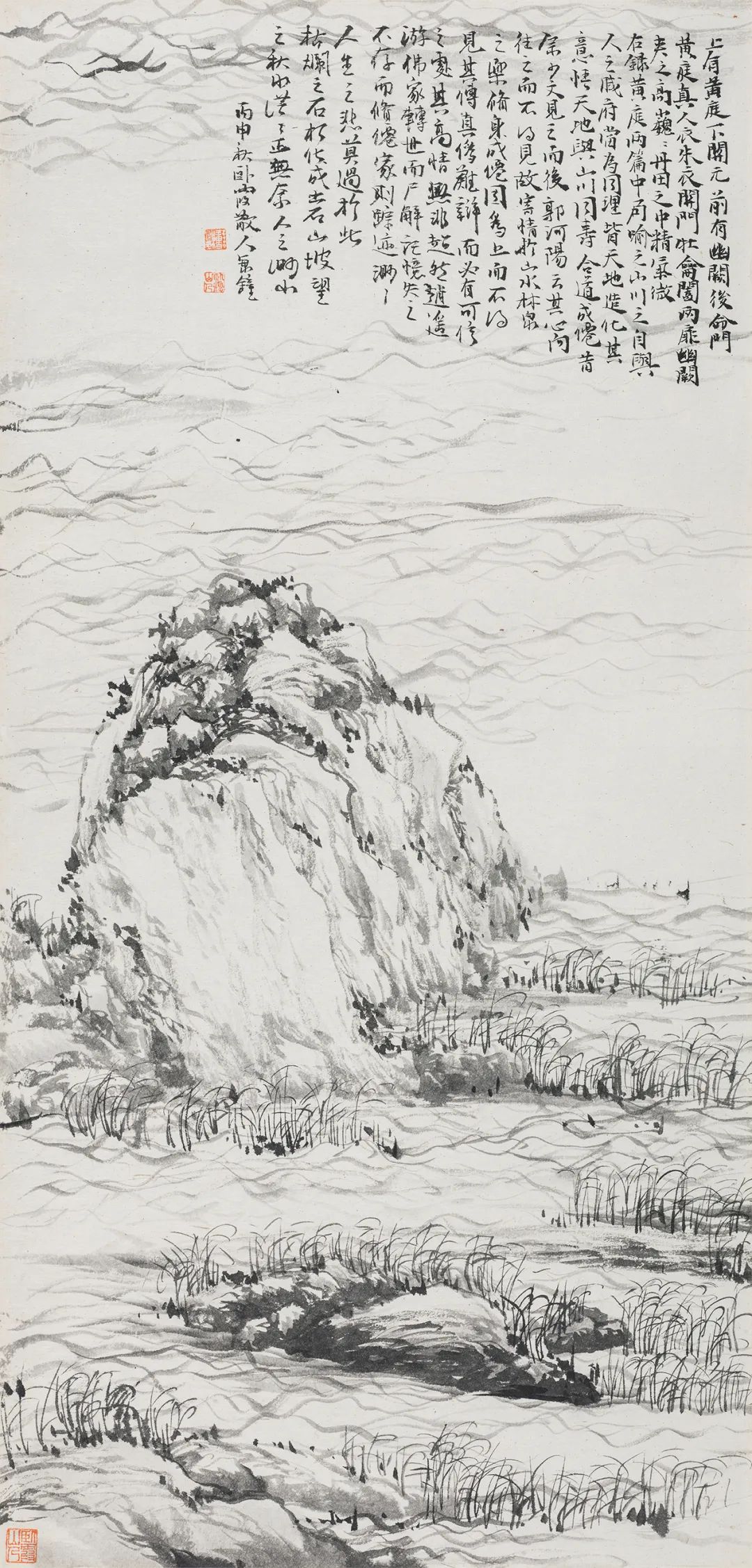 遥山动波图纸本水墨 Ink on paper67x33cm2016
遥山动波图纸本水墨 Ink on paper67x33cm2016
By tracing back, we can see that the requirements of brushwork as mentioned in Brushwork Notes: “without matter or form, like flying and moving” is the pursuit of independent aesthetics of the brushwork. That “Using the brush in bone method” refers to power, and that “one stroke” refers to sinew. In saying that “the brushwork, although following rules, operates flexibly”, rules are ones that the brushwork follows, and “flexibility” is that in what Huang Binhong called “smooth, controllable, elastic, powerful, and flexible”. This is also the characteristics of Lin Haizhong’s brushwork: “all points and strokes are out of surprise”, and the postures of brushwork and combinations are billowing, beautiful and powerful. After more than thirty years of refinement, he has formed his own unique and perfect brush-ink structure.
The brushwork is not so much a technical system as it is a way to control the physical and mental experience of time, a way of self-exercise and self-formation. In the process of time in the present moment, concentration, attention, and focusing on the coherent and intricately changing relationship between strokes allows the frequency of the spirit to flow through the soft fibers of the painting brush, while the heights of spiritual freedom achieved by the ancients are retained in the handwriting. This is why the Zen Buddhist monk’s last words embody a lifetime of enlightenment. The Chinese tradition reaches the threshold of spiritual experience through the crafting of a single thread. It is not by chance that calligraphy became a form of life and emerged in Chinese history in conjunction with Chinese painting. It is another outlet for spiritual power built and developed on the basis of Western shapes, images and blocks of colour, an independent aesthetic system and self-training path for the mind and body, relying on the vitality and spiritual subtleties of the structure built up by the brushwork. The brushwork is also a difficult practical skill, whether in terms of self-technique, aesthetic norms, or spiritual awareness, and has become a child in the dirty water thrown out by the modernist revolution, requiring us to re-examine and treat it when we look back at tradition. The exploration of Lin Haizhong and other artists who continue to practice the brushwork opens the way for our contemporaries to access the ancients in exploring their own selves, training their minds and bodies through self-technique, and thus achieving a state of freedom.
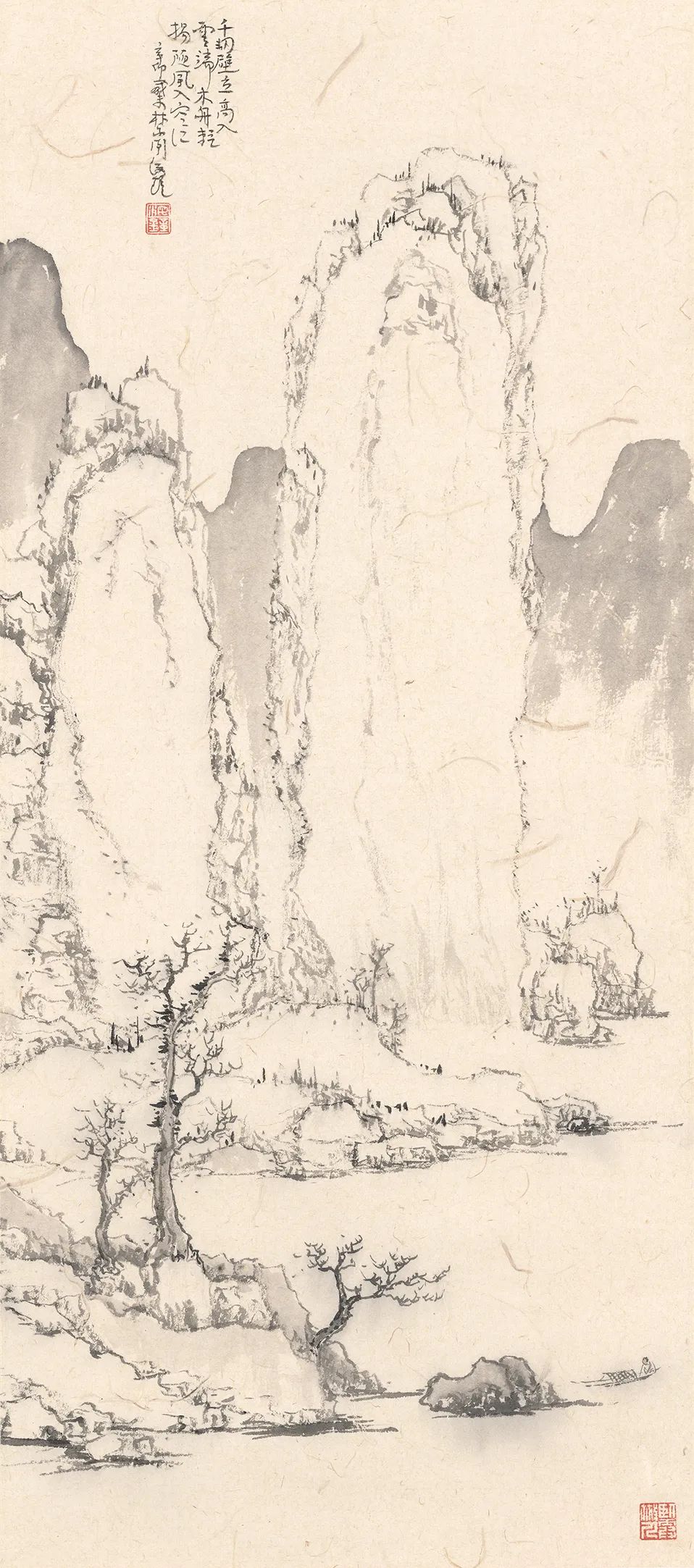 千仞壁立图纸本水墨 Ink on paper74x32cm2011
千仞壁立图纸本水墨 Ink on paper74x32cm2011
In Brushwork Notes, it is said that “wash painting emerged in our Tang Dynasty”, and its using of ink is still viewed as coloring. Lin Haizhong, on this basis combining with the painting theories of the succeeding generations, puts forward the idea that “the brushwork is the ink and the ink is the brushwork”, that is to say, that the use of ink and color also requires the use of the brush. Only by using the brush in the ink can one “blossom in the world of ink”, as Shi Tao said, and his practice has advanced on the basis of Jing Hao’s theory.
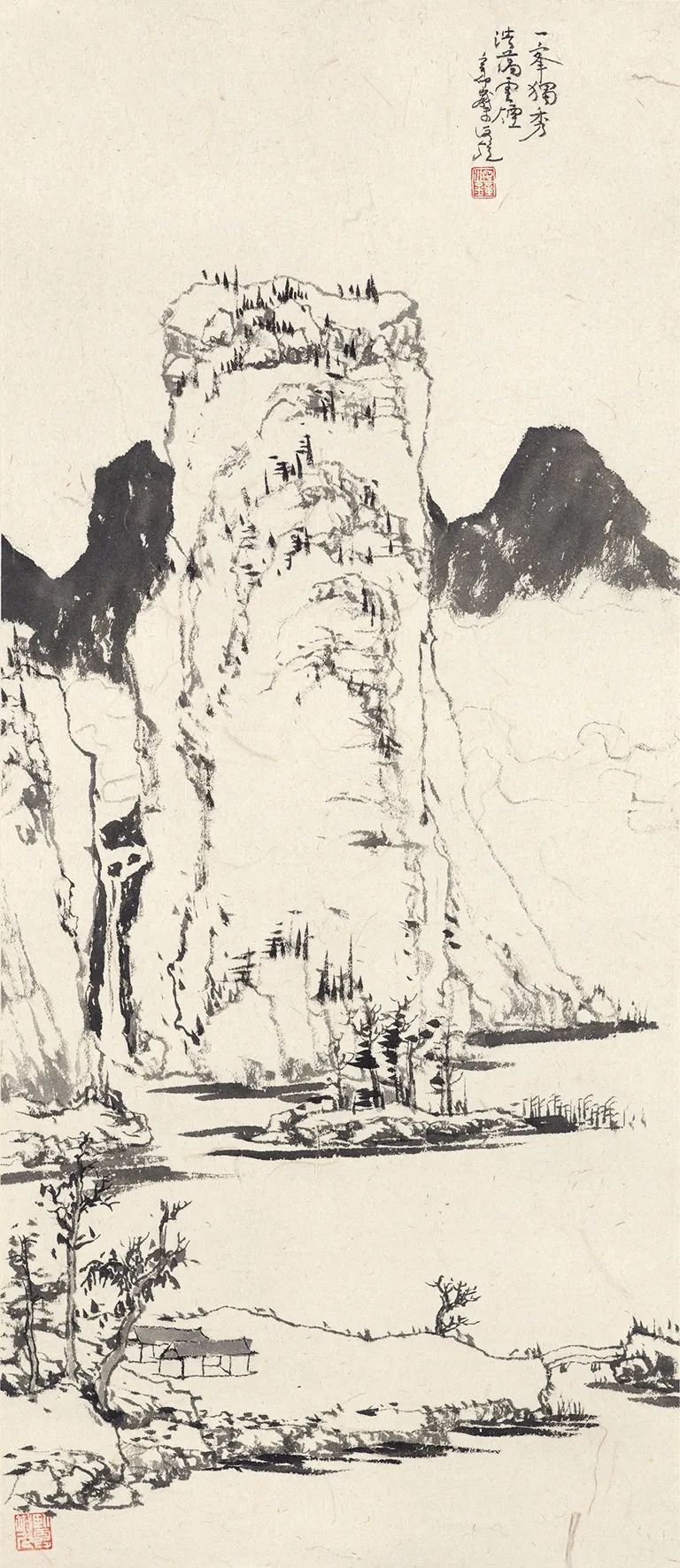 一峰独秀图纸本水墨 Ink on paper74.5x32cm2011
一峰独秀图纸本水墨 Ink on paper74.5x32cm2011
III. “Thought and Scene” and “Four Qualities”
In Brushwork Notes, it is said that “thinking is to draw out the main points, and to visualize the form”. The idea is about the subjective choice of the arrangement of the whole piece of work, and about the creation of the conceptual perception. “What so-called scene is to extract the elements of beauty from the scenery in front of you, to study its truth, and to discover its subtleties.” That means to make a thorough inquiry into the pattern of the mountains and rivers, and through the subtleties of the images of things to reveal the truth. Four-quality is meant to clarify the further evaluation standard of “thought” and “scene”: the highest standard is “spirit”, which “has no action, and forms the image in nature”, presenting the concept of becoming of the heavenly way in nature which is in line with the spirit of Taoism. All the becoming of chaotic combination by chance is a kind of natural state of generative movement. It can be understood as the manifestation of the interplay of yin and yang, a kind of pre-established pattern. That “What so-called subtlety is the thought through heaven and earth, all kinds of dispositions, the appearance of texture and pattern, and the schema of things and the flow of the brush”, on the other hand, emphasizes the top-down rational perspective seeing the world in landscape painting. Jing Hao’s detailed discussion of the characteristics of the growth of pine and cypress in terms of the doctrine of Analogies to Virtues, his observations of the biodiversity of rowan, tung, oak, elm, willow, mulberry, and acacia with their different shapes and qualities, and the topography and geology of peaks, tops, ridges, caverns, cliffs, rocks, valleys, streams, and ravines, and the meteorological phenomena of fog and clouds, are all about the empirical content of all things in heaven and earth, showing a respect for objective experience and natural norms, and an observation of the pattern of becoming of all things based on the dichotomy of the body and the image of dispositions, which is characterized by the worldview of Confucianism in the light of heavenly pattern and its manifestation in the landscape. “What so-called strangeness means the unpredictable traces, the possible deviation from the real scene. Those who get strangeness from the biased pattern have a painting without thinking”. In consideration of Jing Hao’s comments on other painters, it can be seen that he attaches importance to “thought” and “pattern”, and the order of the real and theoretical worlds becomes very important, emphasizing the order of naturally becoming and actualization route of landscape painting, and also expressing a certain degree of criticism of the aesthetic of the deviation from the real scene. “What so-called ingeniousness means embellishing, pretending to fit in with the great law, deliberately crafting to depict the image in stacking. This can be said insufficient in content but surplus in prosperity”. His strong disdain for craftsmanship and falsification puts the work’s intrinsic compatibility with the Great Tao in an absolute position. The truth behind the phenomenon is “disposition”, “heavenly pattern”, and “Tao”, which transcend all appearances, and are beyond the reach of all superficial craftsmanship.
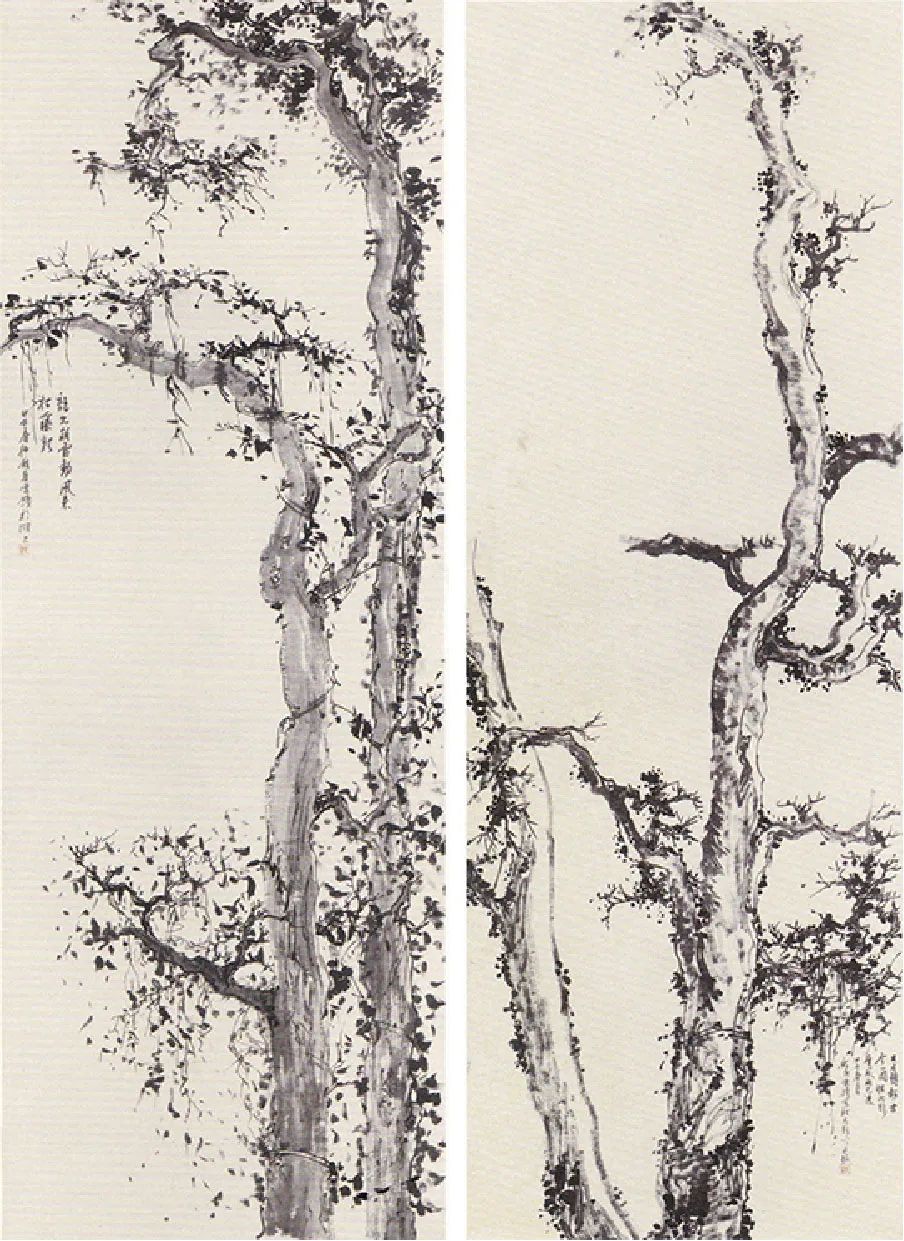 枯木龙吟之老龙岭(右)、枯木龙吟之风雪动(左)纸本水墨 Ink on paper217x77cm2014
枯木龙吟之老龙岭(右)、枯木龙吟之风雪动(左)纸本水墨 Ink on paper217x77cm2014
A later in the Song Dynasty, Guo Xi’s The Heart of Forest and Spring describes the realm of landscapes as follows: “What is the purpose of a gentleman’s love for landscapes? The hill garden is the place where one can cultivate one’s disposition; the spring-rock is the place where one feels free; the fisherman and the woodcutter are who one is always at ease with; the apes and the cranes are what one is always close to. The clamor and constraints of the world are what humankind are always tired of. The immortals and saints are what humankind often wish to see but cannot see. ... However, there are the aspiration to living in the forest-spring and the ideal of being companied with the smoke-haze even in dreams, though ears and eyes are cut off when dreaming. Today’s masters of painting are so interested in painting the beautiful scenery of springs and rocks that they do not have to go out of their halls, but can explore them while sitting in their seats, with the cries of the apes and birds in their ears, and the light of the mountains and the colors of the water brightly shining, so isn’t it pleasing to the human mind and appealing to my heart? This is the original intention of the world to cherish landscape paintings. If you do not cherish them, but treat them with an irreverent heart, are you not confused?”
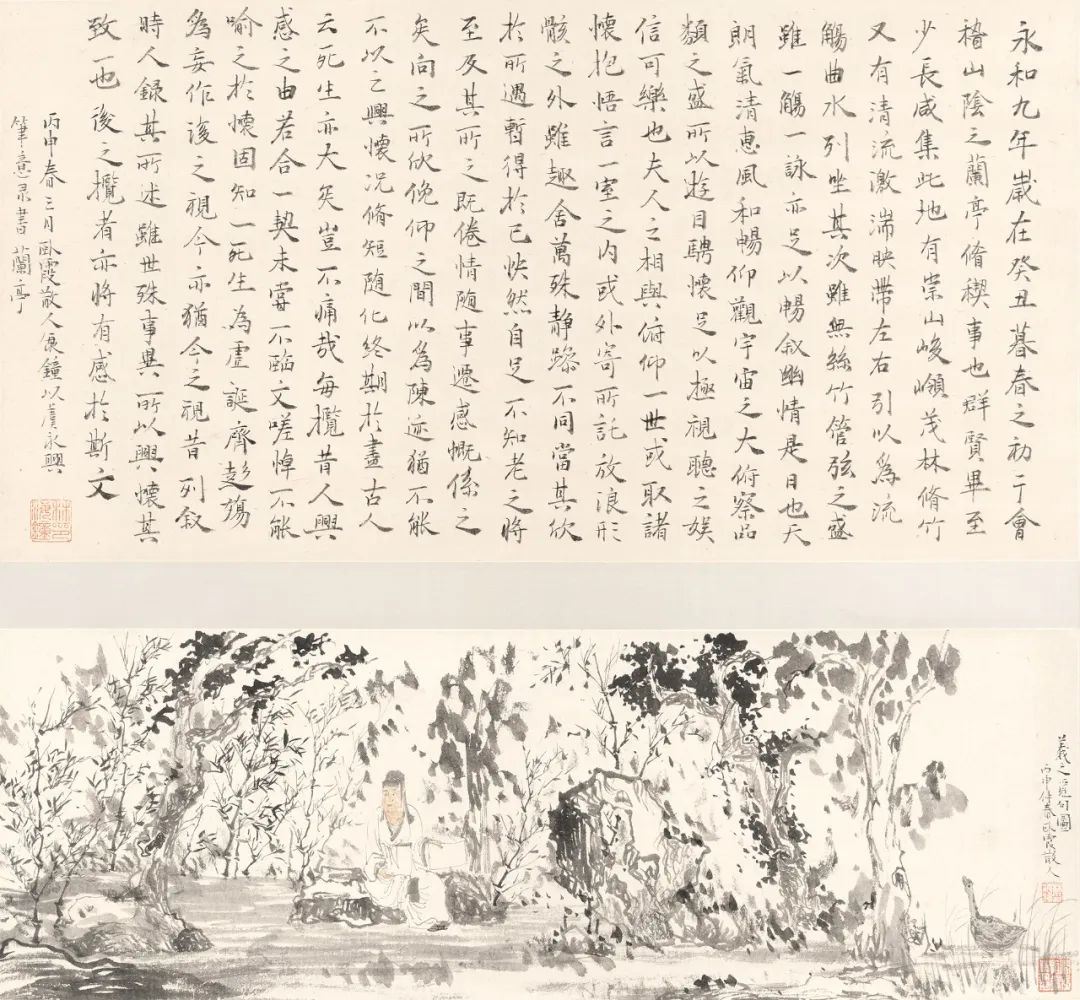 羲之觅句图纸本水墨 Ink on paper60x65cm2016
羲之觅句图纸本水墨 Ink on paper60x65cm2016
Landscape paintings in the Five Dynasties and Song Dynasty are meant to express the ideal of completing one’s disposition or reason, and the feeling of living in seclusion in a place far removed from the world. This is also Lin Haizhong’s basic mindset, and, in the study over the years, he has broken through the norms of ancient sages, finding that the mountains-and-rivers is a proper place for making a thorough inquiry into truth and cultivating the aspiration to living in seclusion. With the reading and understanding of Brushwork Notes, the wonderful paintings of Lin Haizhong’s several journeys through the Taihang Mountains, the video recordings of his trips to the Taihang Mountains edited by Mr. Fan Li, and the photos of various editions of the book in history took by Gao Jin in libraries all over the world, invite us to enter into the place of experiencing the Tao and the realm of Becoming created by Lin Haizhong.
Hangzhou, 13th August 2023
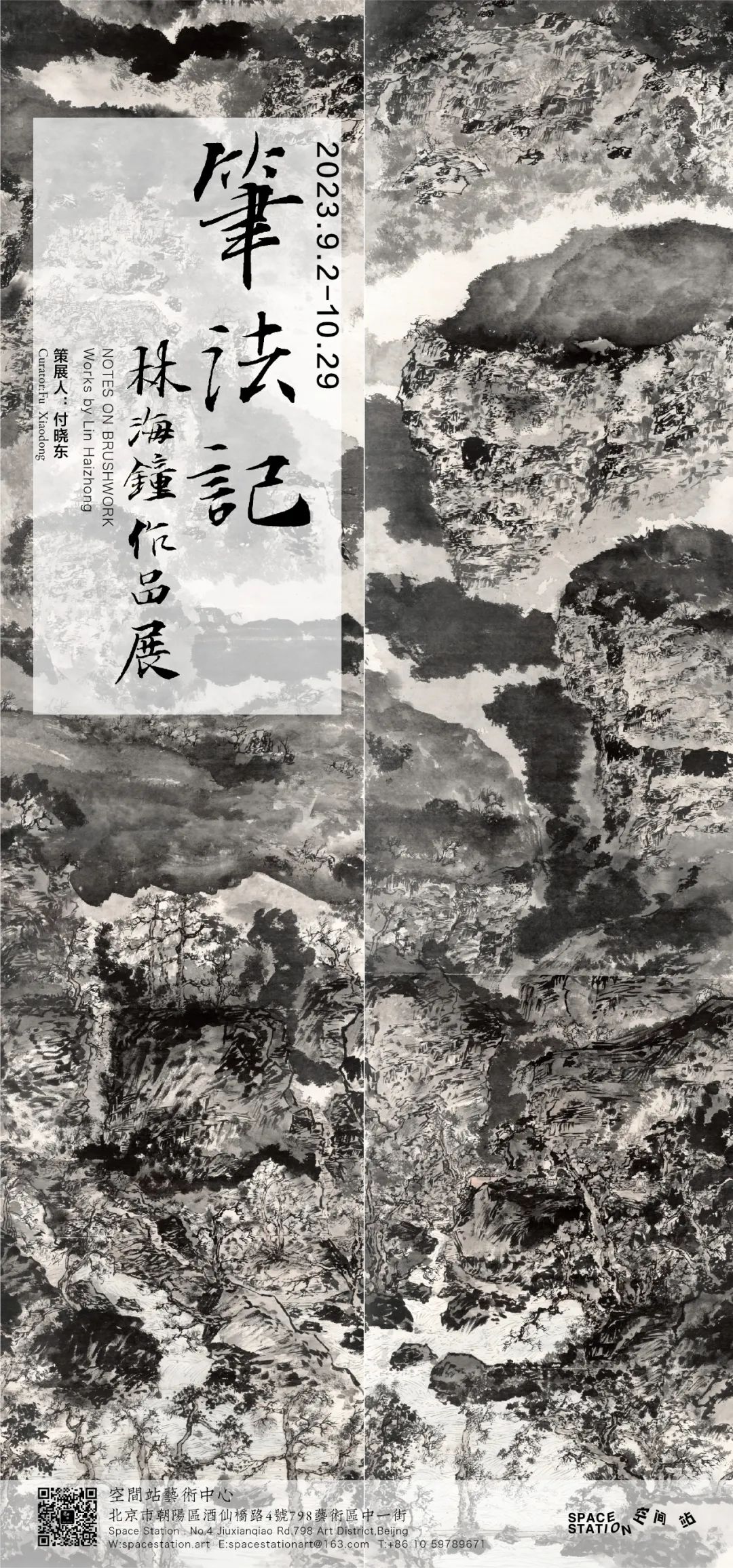
(来源:空间站艺术中心)
画家简介
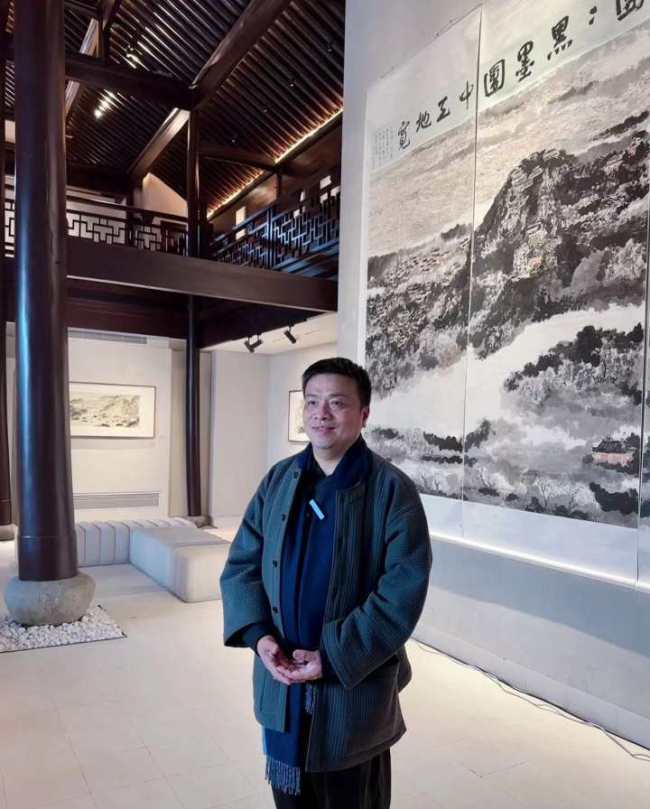
林海钟
现为中国美术学院中国画系教授/博士生导师。号卧霞散人钱塘后来生林泉阁主人
1968年生于浙江杭州
1986年考入中国美术学院中国画系
1990年中国美术学院中国画系本科毕业,保送攻读硕士研究生学位
1991年获首届中国美术学院“潘天寿奖学金”
1993年获中国美术学院国画系硕士学位并留校任教
1997-1999年任中国美术学院中国画系山水教研室主任
2000年攻读博士学位,成为首届中国画6博士之一
2010年担任博士生导师
